Stan C. Smith's Blog, page 26
September 29, 2020
Awesome Animal - Electric Eel
The very idea of an electric fish seems like some outrageous science fiction creature dreamed up by... well, an author like myself. Even its scientific name sounds like science fiction: Electrophorus electricus. But, I assure you, this creature is real.
Shocking, huh?
What the heck is an Electric Eel?
Well, for starters, it isn't an eel at all. The electric eel is actually a type of knifefish, which means it's more closely related to catfish than to eels. They live in dark, murky rivers in South America, including the Amazon.
These fish use their electrical superpowers in several fascinating ways, mostly for locating and then subduing their prey, typically smaller fish.
Electric eels are large fish, typically growing over six feet (2 m) long and weighing 44 pounds (20 kg). Like catfish, electric eels do not have scales.
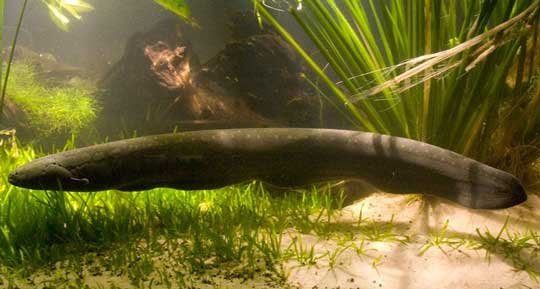
Amazing Facts about Electric Eels
Obviously, we need to explore this whole electric thing, right? There's a lot here to consider, so I'll try to organize it logically.
First, how in the heck do these fish generate a voltage? Basically, the electric eel has an amazing nervous system. Its nervous system can synchronize the activity of a series of specialized, disc-shaped cells that produce electricity. These cells are contained within a specialized electric organ. Actually, there are three pairs of these organs, and the organs can make up to 80% of the animal's body!
The disc-shaped cells are called electrocytes, and they are lined up within the organs so that a current of ions can flow through them. When the fish's brain decides to generate a shock, it sends a signal through its nervous system to the organs. Without getting too technical, I'll just say that this signal causes a sudden switch in the organ's polarity, thus generating an electrical current. Think of the organ as a battery, which has a series of stacked discs that produce a current in a similar way.
You see, the eel must activate all the electrocytes at once for this to work. The problem is, these cells are at different distances from the brain. That's where the fish's amazing nervous system comes in... the system has a complex array of nerves that makes sure all the cells activate at the exact same time, no matter how far out they are! Mind boggling, if you ask me.
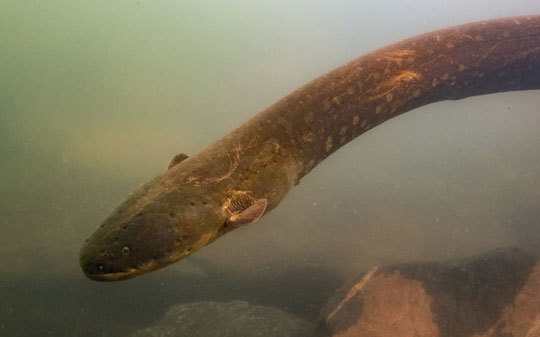
How powerful is the shock? An electric eel can generate up to 860 volts and up to 1 amp of current. Is that enough voltage to kill a person? Probably not, but it would be painful, and it could incapacitate a person long enough for them to drown. Such drownings have occurred, although they are rare.
To give you an idea of what the shock might be like, consider this story from Philip Stoddard, a zoologist at Florida International University in Miami. Philip had a five-foot-long electric eel as a pet in an aquarium. The eel's name was Sparky. One day Philip decided he wanted to reach into the aquarium and pet Sparky. Philip knew the risk, but he figured the fish was comfortable around him and wouldn't feel threatened (hmm... ).
So, he reached in and stroked the fish's back. You can guess what happened, right? The fish zapped him with 500 volts of electricity, more than four times the shock he would get by sticking his finger into a typical North American household socket (for various reasons, here in the US we use 110-volt outlets—actually they are closer to 120 volts these days—whereas many other countries use 220). Anyway, Philip got a powerful shock. His entire arm hurt for about an hour.
Check out this video about how electric eels can defend themselves with electricity.
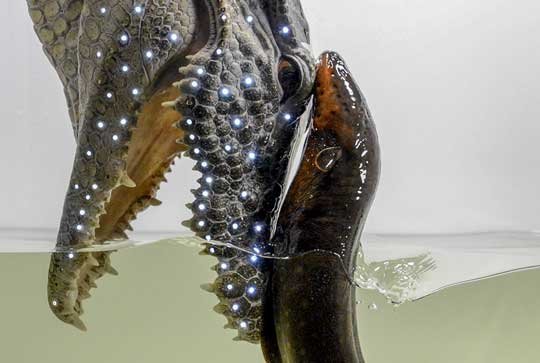
Now that we've talked about HOW they produce electricity, let's explore WHY they do this.
Obviously, one reason is for defense against predators. An electric eel can actually kill an attacking caiman that is trying to eat it. Even if the predator isn't killed, it will immediately realize it has made a mistake and will back off. Or, it will be incapacitated long enough for the eel to escape (you might find this a little disturbing, but here is a video recorded by a fisherman who catches an electric eel, then a caiman tries to attack the eel as the guy is reeling it in... the caiman appears to be killed).
But the eel's use of electricity is much more complex than just predator defense. They use their electricity in multiple ways.
They use low voltages to sense their surroundings, kind of like an electrical version of sonar. Remember, these fish live in muddy, murky water, and they have poor eyesight, so this low-voltage sensory ability comes in handy.
They use high voltages in several ways.
High-voltage use #1: To detect prey. The eel can emit pairs of high-voltage pulses, 500 of these pulses per second. These pulses cause their hidden prey to involuntarily twitch. The eel can sense these twitches (remember that low voltage use described above?), allowing it to locate the prey animal.
High-voltage use #2: To stun or kill prey. Once the eel locates the prey, it emits even higher-voltage pulses at 400 pulses per second. This stuns the prey fish, and the eel can approach it and suck it into its mouth with one gulp.
One more interesting morsel about electric eels. An electric eel at the Tennessee Aquarium has its own Twitter account. Yes, you read that right. The fish's name is Miguel Wattson. The fish's tank is set up to constantly monitor its electrical output. Whenever Miguel Wattson gets excited and generates enough electricity, this activates a connected computer to send out a pre-written tweet, many of which are clever and fun. Here's an example:
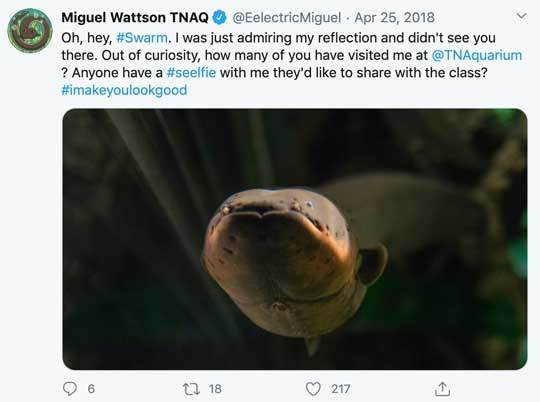
You can follow Miguel's tweets here.
Here's an older one:

So, the Electric Eel deserves a place in the S.A.H.O.F.
(Stellar Animal Hall of Fame).
FUN FACT: The word stellar originated in the 1650s, as an adjective meaning "pertaining to stars or star-like." Beginning in 1883, it was used in a theatrical sense of the word star (as in the star of a play). In this sense, stellar meant "outstanding, leading." Eventually, people started broadening its use to refer to anything that was outstanding, such as, "The company thrived, due to stellar management."
So, stellar is another way to say awesome!
Photo Credits:
Electric eal #1 - BRIAN GRATWICKE / FLICKR (CC BY-NC 2.0)
Electric eel #2 - L. Sousa via Phys.org
Electric eel and alligator prop - Awesome Ocean
Shocking, huh?
What the heck is an Electric Eel?
Well, for starters, it isn't an eel at all. The electric eel is actually a type of knifefish, which means it's more closely related to catfish than to eels. They live in dark, murky rivers in South America, including the Amazon.
These fish use their electrical superpowers in several fascinating ways, mostly for locating and then subduing their prey, typically smaller fish.
Electric eels are large fish, typically growing over six feet (2 m) long and weighing 44 pounds (20 kg). Like catfish, electric eels do not have scales.

Amazing Facts about Electric Eels
Obviously, we need to explore this whole electric thing, right? There's a lot here to consider, so I'll try to organize it logically.
First, how in the heck do these fish generate a voltage? Basically, the electric eel has an amazing nervous system. Its nervous system can synchronize the activity of a series of specialized, disc-shaped cells that produce electricity. These cells are contained within a specialized electric organ. Actually, there are three pairs of these organs, and the organs can make up to 80% of the animal's body!
The disc-shaped cells are called electrocytes, and they are lined up within the organs so that a current of ions can flow through them. When the fish's brain decides to generate a shock, it sends a signal through its nervous system to the organs. Without getting too technical, I'll just say that this signal causes a sudden switch in the organ's polarity, thus generating an electrical current. Think of the organ as a battery, which has a series of stacked discs that produce a current in a similar way.
You see, the eel must activate all the electrocytes at once for this to work. The problem is, these cells are at different distances from the brain. That's where the fish's amazing nervous system comes in... the system has a complex array of nerves that makes sure all the cells activate at the exact same time, no matter how far out they are! Mind boggling, if you ask me.

How powerful is the shock? An electric eel can generate up to 860 volts and up to 1 amp of current. Is that enough voltage to kill a person? Probably not, but it would be painful, and it could incapacitate a person long enough for them to drown. Such drownings have occurred, although they are rare.
To give you an idea of what the shock might be like, consider this story from Philip Stoddard, a zoologist at Florida International University in Miami. Philip had a five-foot-long electric eel as a pet in an aquarium. The eel's name was Sparky. One day Philip decided he wanted to reach into the aquarium and pet Sparky. Philip knew the risk, but he figured the fish was comfortable around him and wouldn't feel threatened (hmm... ).
So, he reached in and stroked the fish's back. You can guess what happened, right? The fish zapped him with 500 volts of electricity, more than four times the shock he would get by sticking his finger into a typical North American household socket (for various reasons, here in the US we use 110-volt outlets—actually they are closer to 120 volts these days—whereas many other countries use 220). Anyway, Philip got a powerful shock. His entire arm hurt for about an hour.
Check out this video about how electric eels can defend themselves with electricity.

Now that we've talked about HOW they produce electricity, let's explore WHY they do this.
Obviously, one reason is for defense against predators. An electric eel can actually kill an attacking caiman that is trying to eat it. Even if the predator isn't killed, it will immediately realize it has made a mistake and will back off. Or, it will be incapacitated long enough for the eel to escape (you might find this a little disturbing, but here is a video recorded by a fisherman who catches an electric eel, then a caiman tries to attack the eel as the guy is reeling it in... the caiman appears to be killed).
But the eel's use of electricity is much more complex than just predator defense. They use their electricity in multiple ways.
They use low voltages to sense their surroundings, kind of like an electrical version of sonar. Remember, these fish live in muddy, murky water, and they have poor eyesight, so this low-voltage sensory ability comes in handy.
They use high voltages in several ways.
High-voltage use #1: To detect prey. The eel can emit pairs of high-voltage pulses, 500 of these pulses per second. These pulses cause their hidden prey to involuntarily twitch. The eel can sense these twitches (remember that low voltage use described above?), allowing it to locate the prey animal.
High-voltage use #2: To stun or kill prey. Once the eel locates the prey, it emits even higher-voltage pulses at 400 pulses per second. This stuns the prey fish, and the eel can approach it and suck it into its mouth with one gulp.
One more interesting morsel about electric eels. An electric eel at the Tennessee Aquarium has its own Twitter account. Yes, you read that right. The fish's name is Miguel Wattson. The fish's tank is set up to constantly monitor its electrical output. Whenever Miguel Wattson gets excited and generates enough electricity, this activates a connected computer to send out a pre-written tweet, many of which are clever and fun. Here's an example:

You can follow Miguel's tweets here.
Here's an older one:

So, the Electric Eel deserves a place in the S.A.H.O.F.
(Stellar Animal Hall of Fame).
FUN FACT: The word stellar originated in the 1650s, as an adjective meaning "pertaining to stars or star-like." Beginning in 1883, it was used in a theatrical sense of the word star (as in the star of a play). In this sense, stellar meant "outstanding, leading." Eventually, people started broadening its use to refer to anything that was outstanding, such as, "The company thrived, due to stellar management."
So, stellar is another way to say awesome!
Photo Credits:
Electric eal #1 - BRIAN GRATWICKE / FLICKR (CC BY-NC 2.0)
Electric eel #2 - L. Sousa via Phys.org
Electric eel and alligator prop - Awesome Ocean
Published on September 29, 2020 17:19
September 22, 2020
Awesome Animal - Shoebill
Hmm... usually I explain why I chose the particular animal as the Awesome Animal. This time, the reason is pretty silly. I saw a photo of a Shoebill, and I thought, look at that crazy bill! That's it. Sometimes my reasons are not particularly intellectual.
What the heck is a Shoebill?
This bird is sometimes called the shoe-billed stork, or the whalehead. Figuring out exactly what the shoebill is has been an ongoing challenge. For years it used to be classified as one of the storks. However, anatomical studies (looking at the structure) suggest it is more closely related to pelicans. But then, molecular studies have convinced many scientists that it is actually more closely related to herons. I guess the jury is still out on that. Because of all this confusion, the bird has been placed in its own special family (called Balaenicipitidae... just try to pronounce that one).
Apparently, the shoebill's closest living relative is another odd-looking bird called the hamerkop . Anyway, they're a big, impressive-looking bird. Shoebills are taller than a mailbox, sometimes standing five feet (152 cm) tall, with an 8-foot wingspan!
Shoebills live in central and eastern Africa, and they eat an impressive variety of prey.

Amazing Facts about Shoebills
First, we need to talk about that bill. The bill is sturdy, heavy, and perfectly adapted for the bird's methods of catching prey. Here's why it's so heavy and sturdy: The shoebill hunts by standing still or walking slowly and carefully, watching for anything that moves that it can swallow (and shoebills can swallow a lot!). When it spots an animal, the bird throws itself forward with every ounce of strength it has, and its bill crashes into the water at full speed.
Here is a brief video that shows a shoebill hunting.
Often, when a shoebill grabs a prey animal like this, it also gets a mouthful of water plants and mud. No problem, though. The bird is skilled at shifting its jaws back and forth to discard the salad and keep the meat.
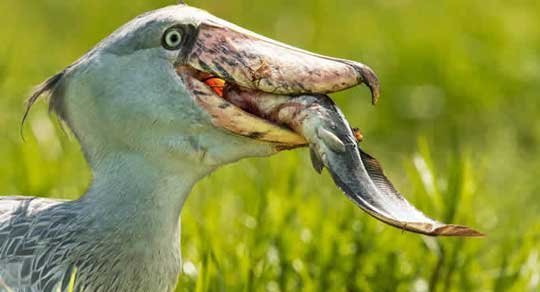
I mentioned above that shoebills eat an impressive list of prey. They are particularly fond of lungfish (see above photo), but they will eat pretty much any creature they can swallow whole. This includes not only surprisingly large lungfish, but also eels, catfish, and frogs. As if that weren't impressive enough, they do not hesitate to eat monitor lizards, snakes, and even young crocodiles. Yep, this is a bird that eats crocodiles.
So, it grabs a mouthful of stuff, shakes out everything else except for the prey animal, then it often maneuvers the animal around until it can decapitate it with its sharp-edged bill. Easier to swallow that way, I suppose. And swallow it does—whole. All at once. Down the hatch. Gulp.
But wait! Even though the bird has eaten its prey, it isn't quite finished with it yet. Sorry, but this part is a little disgusting. Shoebills live in hot places, and to help cool themselves down, they poop on their legs. That's right. How does it work? Well, bird poop is mostly liquid, and when the poop evaporates, it cools the blood circulating through the shoebill's legs, and that cooled blood cools the rest of the bird's body. Isn't that cool?
Um, is it me, or does the shoebill look a little like the long-lost dodo bird?
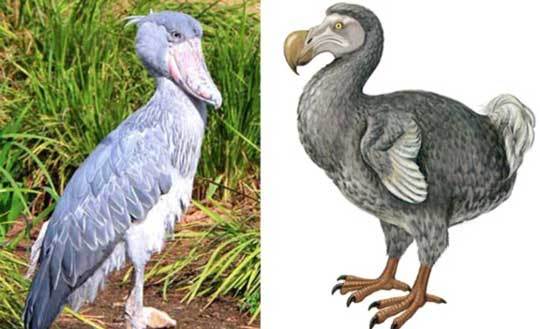
Hey, why do they call them shoebills? What kind of shoe looks like that? A Dutch wooden clog, of course, and that's how they got their name.
Remember when I said shoebills often hunt by standing still and waiting? I wasn't kidding. You wouldn't want to get into a staring contest with one of these birds because they are capable of standing in one place and staring at the water for hours at a time. They could teach us all a thing or two about the virtues of patience.
Shoebills have large, gold-colored eyes, and when they look directly at you, their stare is rather intimidating. It makes you feel like they are sizing you up, deciding if you are small enough to swallow whole.
Here's a random thought. To me, the shoebill looks very dinosaur-like. Its scientific name is Balaeniceps rex . In other words, it is named B. rex . If you've seen the Jurassic Park movies, you know what a T. rex's death stare looks like. Well, here's the B. rex's death stare:

Don't get me wrong. I'm not implying that shoebills are ill-tempered or dangerous to people. They actually seem quite tolerant of people (although you have to admit... that stare!). Shoebills in zoos seem to like it when approaching people mimic their movements, including bowing to the bird.
Check out this video of these behaviors in a shoebill in captivity.
If you watch videos of a shoebill, you will see and hear it clacking its bill loudly (you can see this in the above video). This is a common form of communication between the birds. They seem to do it most when they are around their nests, although the specific purpose of the sound is uncertain.
One more item of interest. Adult shoebills are certainly strange-looking birds. You must be wondering what baby shoebills look like. In 2009 the Lowry Park Zoo in Tampa, Florida was only the second zoo in the world to successfully hatch a baby shoebill. As it turns out, newly-hatched shoebills look... well, kind of normal (although maybe a little goofy).
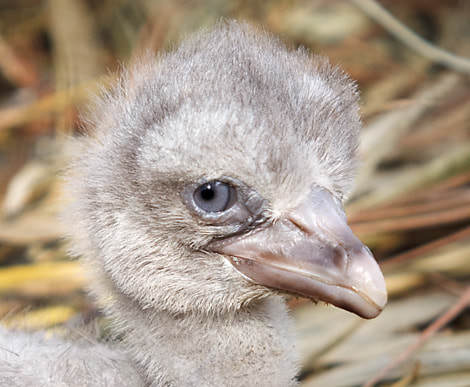
So, the Shoebill deserves a place in the B.A.H.O.F.
(Bumper Animal Hall of Fame).
FUN FACT: The word bumper has numerous meanings. As a noun, it refers to the protective guard on the front of a vehicle, or any other kind of rim, pad, or projection that protects something. It even refers to a glass full to the brim (particularly with beer). In Australia it's a slang word for a cigarette butt. However, when used as an adjective, bumper can mean unusually abundant (such as a bumper crop), but it can also mean unusually large and/or fine. And that, folks, is why I think bumper, particularly when referring to the shoebill, is another way to say awesome!
Photo Credits:
Glow in the datk shark - Zooborns
What the heck is a Shoebill?
This bird is sometimes called the shoe-billed stork, or the whalehead. Figuring out exactly what the shoebill is has been an ongoing challenge. For years it used to be classified as one of the storks. However, anatomical studies (looking at the structure) suggest it is more closely related to pelicans. But then, molecular studies have convinced many scientists that it is actually more closely related to herons. I guess the jury is still out on that. Because of all this confusion, the bird has been placed in its own special family (called Balaenicipitidae... just try to pronounce that one).
Apparently, the shoebill's closest living relative is another odd-looking bird called the hamerkop . Anyway, they're a big, impressive-looking bird. Shoebills are taller than a mailbox, sometimes standing five feet (152 cm) tall, with an 8-foot wingspan!
Shoebills live in central and eastern Africa, and they eat an impressive variety of prey.

Amazing Facts about Shoebills
First, we need to talk about that bill. The bill is sturdy, heavy, and perfectly adapted for the bird's methods of catching prey. Here's why it's so heavy and sturdy: The shoebill hunts by standing still or walking slowly and carefully, watching for anything that moves that it can swallow (and shoebills can swallow a lot!). When it spots an animal, the bird throws itself forward with every ounce of strength it has, and its bill crashes into the water at full speed.
Here is a brief video that shows a shoebill hunting.
Often, when a shoebill grabs a prey animal like this, it also gets a mouthful of water plants and mud. No problem, though. The bird is skilled at shifting its jaws back and forth to discard the salad and keep the meat.

I mentioned above that shoebills eat an impressive list of prey. They are particularly fond of lungfish (see above photo), but they will eat pretty much any creature they can swallow whole. This includes not only surprisingly large lungfish, but also eels, catfish, and frogs. As if that weren't impressive enough, they do not hesitate to eat monitor lizards, snakes, and even young crocodiles. Yep, this is a bird that eats crocodiles.
So, it grabs a mouthful of stuff, shakes out everything else except for the prey animal, then it often maneuvers the animal around until it can decapitate it with its sharp-edged bill. Easier to swallow that way, I suppose. And swallow it does—whole. All at once. Down the hatch. Gulp.
But wait! Even though the bird has eaten its prey, it isn't quite finished with it yet. Sorry, but this part is a little disgusting. Shoebills live in hot places, and to help cool themselves down, they poop on their legs. That's right. How does it work? Well, bird poop is mostly liquid, and when the poop evaporates, it cools the blood circulating through the shoebill's legs, and that cooled blood cools the rest of the bird's body. Isn't that cool?
Um, is it me, or does the shoebill look a little like the long-lost dodo bird?

Hey, why do they call them shoebills? What kind of shoe looks like that? A Dutch wooden clog, of course, and that's how they got their name.
Remember when I said shoebills often hunt by standing still and waiting? I wasn't kidding. You wouldn't want to get into a staring contest with one of these birds because they are capable of standing in one place and staring at the water for hours at a time. They could teach us all a thing or two about the virtues of patience.
Shoebills have large, gold-colored eyes, and when they look directly at you, their stare is rather intimidating. It makes you feel like they are sizing you up, deciding if you are small enough to swallow whole.
Here's a random thought. To me, the shoebill looks very dinosaur-like. Its scientific name is Balaeniceps rex . In other words, it is named B. rex . If you've seen the Jurassic Park movies, you know what a T. rex's death stare looks like. Well, here's the B. rex's death stare:

Don't get me wrong. I'm not implying that shoebills are ill-tempered or dangerous to people. They actually seem quite tolerant of people (although you have to admit... that stare!). Shoebills in zoos seem to like it when approaching people mimic their movements, including bowing to the bird.
Check out this video of these behaviors in a shoebill in captivity.
If you watch videos of a shoebill, you will see and hear it clacking its bill loudly (you can see this in the above video). This is a common form of communication between the birds. They seem to do it most when they are around their nests, although the specific purpose of the sound is uncertain.
One more item of interest. Adult shoebills are certainly strange-looking birds. You must be wondering what baby shoebills look like. In 2009 the Lowry Park Zoo in Tampa, Florida was only the second zoo in the world to successfully hatch a baby shoebill. As it turns out, newly-hatched shoebills look... well, kind of normal (although maybe a little goofy).

So, the Shoebill deserves a place in the B.A.H.O.F.
(Bumper Animal Hall of Fame).
FUN FACT: The word bumper has numerous meanings. As a noun, it refers to the protective guard on the front of a vehicle, or any other kind of rim, pad, or projection that protects something. It even refers to a glass full to the brim (particularly with beer). In Australia it's a slang word for a cigarette butt. However, when used as an adjective, bumper can mean unusually abundant (such as a bumper crop), but it can also mean unusually large and/or fine. And that, folks, is why I think bumper, particularly when referring to the shoebill, is another way to say awesome!
Photo Credits:
Glow in the datk shark - Zooborns
Published on September 22, 2020 17:42
September 7, 2020
Awesome Animal - Velvet Worm
Yesterday I was writing one of the chapters of the third Across Horizons book, and I decided the scene needed a really strange creature. I dug around for ideas and decided on a velvet worm. I then read a few articles on velvet worms, and I was blown away by these creatures. Who knew they were so awesome? I decided velvet worms deserved to be featured in this post, and here they are.
What the heck is a velvet worm?
This question is not so easy to answer. In spite of the name, they aren't really worms. They look a little like a caterpillar, but caterpillars are insects. They look a little like a slug, but slugs are mollusks. They actually belong in their own phylum, Onychophora.
We know of about 200 species, mostly living in the tropics. However, they are extremely secretive, living in dark places in leaf litter on the ground and are only active at night. It is almost certain that many more species exist that we have not yet discovered.
Velvet worms are predators, feeding on almost any creatures their own size or smaller. They average about three inches (7.6 cm) long, but some are less than an inch, and some get as long as eight inches (20.3 cm).
One of the most amazing things about velvet worms is the way they catch and eat their prey! Let's get into the details.

Amazing Facts about Velvet Worms
First let's look at why these critters make such interesting predators. They may be called velvet worms, but I think a better name might be spider-man worms. Why? Because they trap their prey by spraying out two jets of sticky goo from their slime cannons. A two-inch velvet worm can shoot this slime out as far as two feet (61 cm). The slime hits the prey animals and immediately begins to harden like sticky glue.
With the prey creature now immobilized, the velvet worm can take its time and safely approach its meal. It has a specialized knife-like tooth hidden in its mouth, which it slides out and uses to cut through the prey animal's skin or exoskeleton. Once a hole is made, the velvet worm injects saliva, which is deadly to the prey animal. Not only does the saliva kill the animal, it also starts to digest the animal's insides. The velvet worm waits patiently as the saliva does its job, keeping itself busy by re-ingesting and thus recycling the goo it had already squirted. Finally, it goes back to the opening it made in the prey animal and starts slurping up the creature's digested insides. Yum!
Check out this video about the velvet worm's slime cannons.
Notice the jets of goo squirting from this velvet worm:
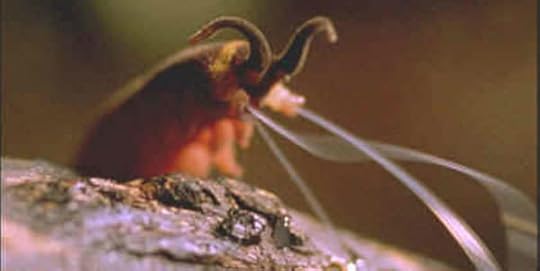
Let's break this amazing predation process down into steps. First, velvet worms have very poor eyesight, so how do they even locate their prey? Those short, squishy-looking legs allow them to move around on the forest floor without being heard. Also, because their legs do not vibrate the surfaces much, their prey cannot feel them approaching. The velvet worms themselves are extremely sensitive to vibrations and changes in air pressure from movement, so they can detect other creatures moving around nearby. They sneak up on their prey very stealthily, and they get so close that they can touch the prey with their finger-like antennae. Their antennae are highly sensitive, and velvet worms very lightly touch the prey animal to determine if it would be suitable as a meal. Often they spend a full ten seconds touching the animal without scaring it off!
Check out the antennae on the blue velvet worm below:
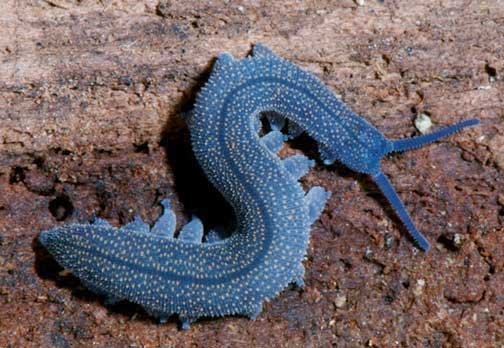
Once the velvet worm decides the prey is suitable and worth using up some of its precious slime, it squirts the slime through its two slime nozzles.
But where does the slime come from, and what is it? The velvet worm has two huge slime glands inside its body that run most of its entire length, allowing it to produce an impressive amount of the goo.
The slime itself is amazing stuff. Its main ingredient is a special type of protein that, when the protein molecules join together, they quickly form a solid structure. But inside the velvet worm's body, and while the slime is being squirted, the proteins are coated with water molecules that keep the proteins separate. In fact, 90% of the slime is water that is there to keep the proteins from interacting with each other. But... when the slime hits the prey animal, it spreads out, covering the animal, and the water quickly evaporates. Guess what happens when the water is gone. That's right, the proteins join together and form a biological glue.
The cool thing is, no other animals in the world use biological glue that works like this.
As I stated above, once the prey is immobilized, the velvet worm casually approaches and cuts a hole in the prey's body to inject saliva that digests the animal from the inside. The saliva contains hydrolytic enzymes, which use water molecules to break the chemical bonds of the prey animals' internal organs. Once that's done, all the velvet worm has to do is suck up all that digested stuff. It's like sucking the water out of a coconut through a straw.
I know... kind of gross, but you have to admit it's also awesome!
Here's an animated GIF of the velvet worm's specialized mouth. I like to think of it as the SSSIPSO (Shell Slicing, Saliva Injecting, Prey Slurping Orifice).

Okay, one more fascinating thing about velvet worms. Most of the velvet worm species live and hunt alone, but at least a few species live in groups with complex social structures, and they even hunt cooperatively. Velvet worms in the genus Euperipatoides live together in groups of up to fifteen. Each group will make a home together, usually somewhere like inside a rotting log, and the members of the group are really aggressive to velvet worms from other logs.
Each group has one dominant member, usually a female. The group leaves the log at night to hunt as a pack, making it easier to capture prey (15 velvet worms... that's a lot of slime). When they make a kill, the dominant female always feeds first. Next, the other females feed, then the males. Finally, the young feed last (assuming there is anything left to eat!).
The social hierarchy is determined by aggression and submission. The biggest, meanest individuals are more dominant. Interestingly, to avoid getting into a fight with a larger individual, velvet worms carefully measure each other by feeling with their antennae from one end of the body to the other. If the opponent is too big, it's safer to simply become submissive.
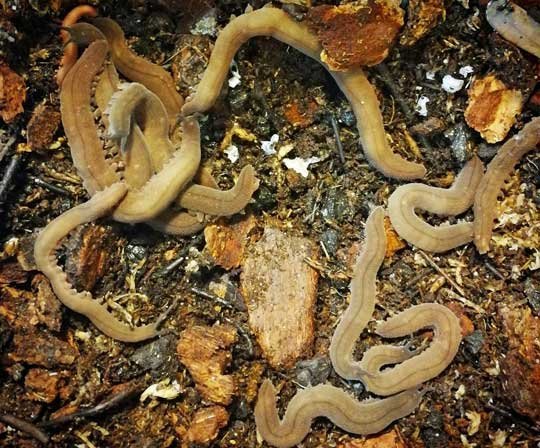
So, Velvet Worms deserve a place in the F.L.A.H.O.F.
(Front-Line Animal Hall of Fame).
FUN FACT: The phrase frontline originated in 1842 as a military term to refer to the location of the most advanced combat units. In about 1910, the hyphenated form (front-line) originated as an adjective, meaning "highly experienced or proficient in the performance of one's duties." In other words, "first-rate," as in She is a front-line performer. So, front-line is another way to say awesome!
Photo Credits:
Velvet worm #1 - Geoff Gallice, Wikimedia Commons
Blue velvet worm - Pinterest
Velvet worm colony - AbraxasComplex on Arachnoboards
What the heck is a velvet worm?
This question is not so easy to answer. In spite of the name, they aren't really worms. They look a little like a caterpillar, but caterpillars are insects. They look a little like a slug, but slugs are mollusks. They actually belong in their own phylum, Onychophora.
We know of about 200 species, mostly living in the tropics. However, they are extremely secretive, living in dark places in leaf litter on the ground and are only active at night. It is almost certain that many more species exist that we have not yet discovered.
Velvet worms are predators, feeding on almost any creatures their own size or smaller. They average about three inches (7.6 cm) long, but some are less than an inch, and some get as long as eight inches (20.3 cm).
One of the most amazing things about velvet worms is the way they catch and eat their prey! Let's get into the details.

Amazing Facts about Velvet Worms
First let's look at why these critters make such interesting predators. They may be called velvet worms, but I think a better name might be spider-man worms. Why? Because they trap their prey by spraying out two jets of sticky goo from their slime cannons. A two-inch velvet worm can shoot this slime out as far as two feet (61 cm). The slime hits the prey animals and immediately begins to harden like sticky glue.
With the prey creature now immobilized, the velvet worm can take its time and safely approach its meal. It has a specialized knife-like tooth hidden in its mouth, which it slides out and uses to cut through the prey animal's skin or exoskeleton. Once a hole is made, the velvet worm injects saliva, which is deadly to the prey animal. Not only does the saliva kill the animal, it also starts to digest the animal's insides. The velvet worm waits patiently as the saliva does its job, keeping itself busy by re-ingesting and thus recycling the goo it had already squirted. Finally, it goes back to the opening it made in the prey animal and starts slurping up the creature's digested insides. Yum!
Check out this video about the velvet worm's slime cannons.
Notice the jets of goo squirting from this velvet worm:

Let's break this amazing predation process down into steps. First, velvet worms have very poor eyesight, so how do they even locate their prey? Those short, squishy-looking legs allow them to move around on the forest floor without being heard. Also, because their legs do not vibrate the surfaces much, their prey cannot feel them approaching. The velvet worms themselves are extremely sensitive to vibrations and changes in air pressure from movement, so they can detect other creatures moving around nearby. They sneak up on their prey very stealthily, and they get so close that they can touch the prey with their finger-like antennae. Their antennae are highly sensitive, and velvet worms very lightly touch the prey animal to determine if it would be suitable as a meal. Often they spend a full ten seconds touching the animal without scaring it off!
Check out the antennae on the blue velvet worm below:

Once the velvet worm decides the prey is suitable and worth using up some of its precious slime, it squirts the slime through its two slime nozzles.
But where does the slime come from, and what is it? The velvet worm has two huge slime glands inside its body that run most of its entire length, allowing it to produce an impressive amount of the goo.
The slime itself is amazing stuff. Its main ingredient is a special type of protein that, when the protein molecules join together, they quickly form a solid structure. But inside the velvet worm's body, and while the slime is being squirted, the proteins are coated with water molecules that keep the proteins separate. In fact, 90% of the slime is water that is there to keep the proteins from interacting with each other. But... when the slime hits the prey animal, it spreads out, covering the animal, and the water quickly evaporates. Guess what happens when the water is gone. That's right, the proteins join together and form a biological glue.
The cool thing is, no other animals in the world use biological glue that works like this.
As I stated above, once the prey is immobilized, the velvet worm casually approaches and cuts a hole in the prey's body to inject saliva that digests the animal from the inside. The saliva contains hydrolytic enzymes, which use water molecules to break the chemical bonds of the prey animals' internal organs. Once that's done, all the velvet worm has to do is suck up all that digested stuff. It's like sucking the water out of a coconut through a straw.
I know... kind of gross, but you have to admit it's also awesome!
Here's an animated GIF of the velvet worm's specialized mouth. I like to think of it as the SSSIPSO (Shell Slicing, Saliva Injecting, Prey Slurping Orifice).

Okay, one more fascinating thing about velvet worms. Most of the velvet worm species live and hunt alone, but at least a few species live in groups with complex social structures, and they even hunt cooperatively. Velvet worms in the genus Euperipatoides live together in groups of up to fifteen. Each group will make a home together, usually somewhere like inside a rotting log, and the members of the group are really aggressive to velvet worms from other logs.
Each group has one dominant member, usually a female. The group leaves the log at night to hunt as a pack, making it easier to capture prey (15 velvet worms... that's a lot of slime). When they make a kill, the dominant female always feeds first. Next, the other females feed, then the males. Finally, the young feed last (assuming there is anything left to eat!).
The social hierarchy is determined by aggression and submission. The biggest, meanest individuals are more dominant. Interestingly, to avoid getting into a fight with a larger individual, velvet worms carefully measure each other by feeling with their antennae from one end of the body to the other. If the opponent is too big, it's safer to simply become submissive.

So, Velvet Worms deserve a place in the F.L.A.H.O.F.
(Front-Line Animal Hall of Fame).
FUN FACT: The phrase frontline originated in 1842 as a military term to refer to the location of the most advanced combat units. In about 1910, the hyphenated form (front-line) originated as an adjective, meaning "highly experienced or proficient in the performance of one's duties." In other words, "first-rate," as in She is a front-line performer. So, front-line is another way to say awesome!
Photo Credits:
Velvet worm #1 - Geoff Gallice, Wikimedia Commons
Blue velvet worm - Pinterest
Velvet worm colony - AbraxasComplex on Arachnoboards
Published on September 07, 2020 20:07
August 20, 2020
Awesome Animal - Badger
If I did a survey and asked all of you one fact you've heard about badgers, I'm betting the most common answer would have something to do with how mean and vicious they are. Yeah, perhaps part of the reason for this is all the Honey Badger Don't Care jokes and memes (and even a book), which apparently started with a silly YouTube video that now has over 95 million views. By the way... don't watch the
video
if you are offended by foul language.
Are badgers really vicious and fearless? Let's find out!
What the heck is a badger?
Actually, there are 11 species of badgers. They are in the family Mustelidae, which also includes otters, ferrets, weasels, minks, wolverines, and others.
Badgers have short legs and stocky, muscular bodies. Their feet are equipped with impressive claws for digging. Badgers live in burrows that they dig with these impressive claws, and a badger burrow is called a sett, which has resulted in several jokes used by standup comedians: "I had a fat badger joke, but I couldn't fit it in my sett."
The different species of badgers live throughout most of the world, including China, Indonesia, Japan, Malaysia, North America, sub-Saharan Africa, the Arabian Desert, India, and most parts of Europe.
Below is an American badger .
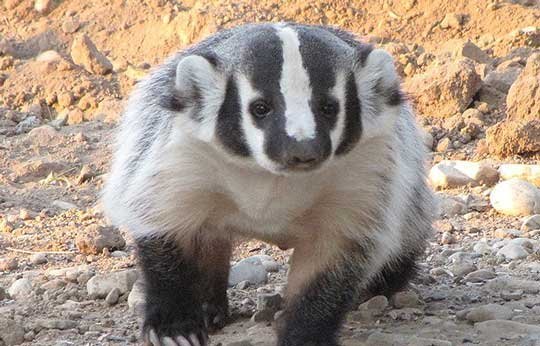
Amazing Facts about Badgers
The name badger originally came from the 16th century word bageard, which meant "marked by a badge." This is a reference to the distinct white stripes on the faces of most badger species.
Some types of badgers live alone, but others live in groups of up to fifteen. A group of badgers living together is called a cete. Their burrows can be extensive, especially when living in groups, and can include numerous passageways and sleeping chambers. For whatever reason, badgers keep their burrows exceptionally clean. They regularly carry out old bedding and bring in fresh bedding, and they defecate only in latrines located outside of their burrows.
Below is a European badger .
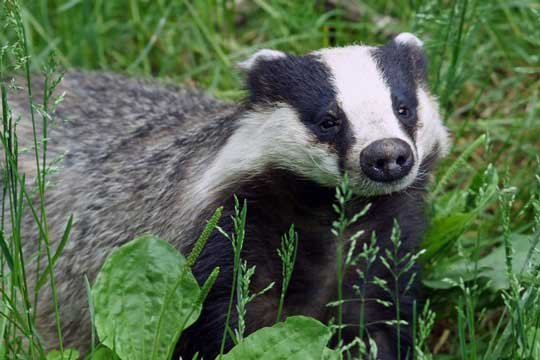
Okay, let's talk about the badger's reputation for being fearless and aggressive. Is it true? As usual, this is often exaggerated. Badgers are certainly capable of defending themselves, and they have powerful jaws and claws, but they rarely attack humans. Of course, like many other animals, a badger will certainly attack a human if you corner it and try to pick it up or harm it. Here's a sampling of evidence of the badger's reputation:
I found an article on the BBC website about a Scottish castle that had to close off part of its public area because a "very angry badger" had gotten into the cellar of the structure.
There are numerous YouTube videos of badgers defending themselves against much larger creatures, including this one of a honey badger taking on six lions. Badgers have really thick, tough skin, and this video shows how these characteristics can save a badger's life.
Also, the honey badger has the Guinness Book of World Records title of "World's Most Fearless Creature."
So, there's no doubt that badgers are fierce creatures and are capable of fighting off attackers.
Perhaps part of their nasty reputation comes from certain behaviors, particularly the notorious honey badger (which lives in Africa and Southeast Asia). For example, honey badgers have a strong resistance to snake venom and scorpion venom. This includes cobra venom, and honey badgers often kill and eat cobras. In fact, 25% of a honey badger's diet is venomous snakes!
Why would the honey badger evolve an immunity to snake venom instead of just avoiding venomous snakes? As one writer put it: "Evolving to withstand snake venom is like being the only person at a party who can eat the extra-hot salsa: You get it all to yourself."
Below is a honey badger :
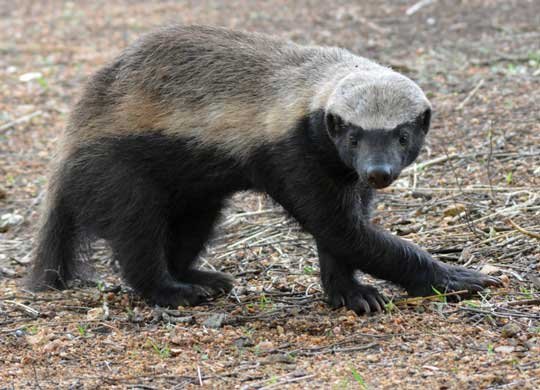
Another major portion of a honey badger's diet is... you guessed it... honey (as well as honeybee larvae). Eating honey involves getting stung by bees. A lot of bees! And, as you can guess, "honey badger don't care!" Again, the thick skin comes in handy. A honey badger's skin is about 1/4 inch (.635 cm) thick and is incredibly tough.
Not only is the badger's skin thick, it's also loose. So loose, in fact, that when a predator gets a badger in its jaws, the badger has room to squirm around and bite the predator's face Badgers also have incredibly strong jaws. Scientists have developed a metric called the Bite Force Quotient (BFQ), which takes into account the bite force and the animal's body size. A European Badger has a BFQ of 106. Compare that to a brown (grizzly) bear, with a BFQ of only 78. The leopard has a BFQ of 94, and the lion had a BFQ of 112. So, the badger rates pretty high in biting force.
This is a long (36 minutes) video, but check it out if you really want to learn a lot about honey badgers.
Honey badgers have no problem going after the difficult foods such as venomous snakes and honey. They even sometimes target porcupines, which have quills that can kill much larger predators. Below is a honey badger that made an attempt to kill a large crested porcupine but finally had to give up.
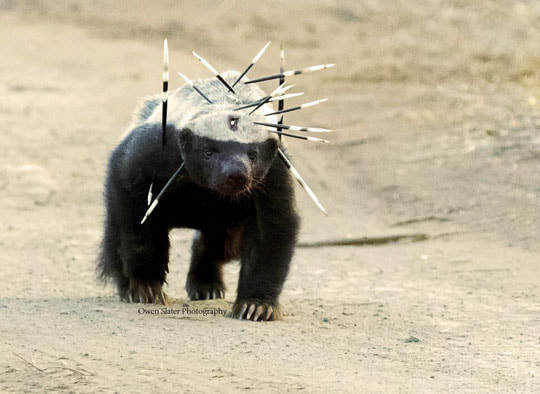
And don't forget there are other species of badgers too. Below is a hog badger in Thailand.
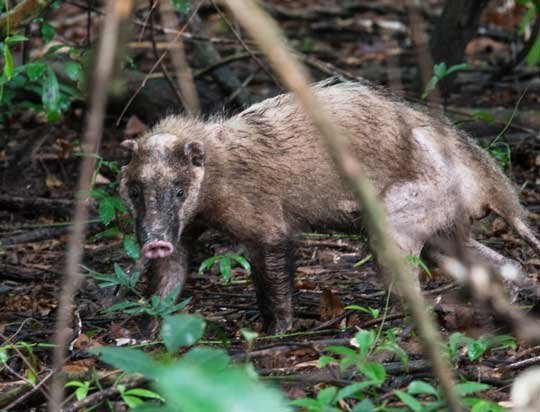
And below is the Javan ferret-badger , which lives in Indonesia. The ferret-badgers are some of the smallest badger species. Most badgers (including the American badger, European badger, and honey badger) average about 25 pounds (11 kg), but the ferret badgers are only about 4 pounds (1.8 kg).
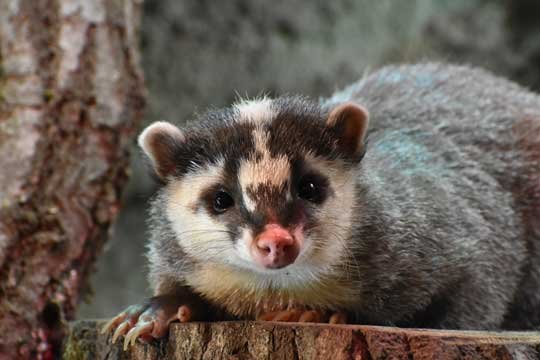
So, Badgers deserve a place in the U.A.H.O.F.
(Undefeated Animal Hall of Fame).
FUN FACT: The word defeat originated way back in the 1300s, and it is most often used as a verb meaning "to overcome in a contest, battle, election, etc." It also means "to frustrate or to thwart." The adjective undefeated didn't show up until hundreds of years later, in the 1700s. Undefeated is now mostly used related to sports, as in "The team had an undefeated season." Considering the badger's reputation as an undefeated fighter, the word seems particularly important here.
So, especially when it comes to badgers, undefeated is another way to say awesome!
Photo Credits:
American Badger - H. Rieser via National Park Service
European Badger - Kallerna/Wikimedia Commons
Honey Badger - South African Biodiversity Institute
Honey badger with porcupine quills - Owen Slater Photography
Hog badger - Wikimedia Commons
Javan ferret-badger - Jiří Bukovský via BioLib
Are badgers really vicious and fearless? Let's find out!
What the heck is a badger?
Actually, there are 11 species of badgers. They are in the family Mustelidae, which also includes otters, ferrets, weasels, minks, wolverines, and others.
Badgers have short legs and stocky, muscular bodies. Their feet are equipped with impressive claws for digging. Badgers live in burrows that they dig with these impressive claws, and a badger burrow is called a sett, which has resulted in several jokes used by standup comedians: "I had a fat badger joke, but I couldn't fit it in my sett."
The different species of badgers live throughout most of the world, including China, Indonesia, Japan, Malaysia, North America, sub-Saharan Africa, the Arabian Desert, India, and most parts of Europe.
Below is an American badger .

Amazing Facts about Badgers
The name badger originally came from the 16th century word bageard, which meant "marked by a badge." This is a reference to the distinct white stripes on the faces of most badger species.
Some types of badgers live alone, but others live in groups of up to fifteen. A group of badgers living together is called a cete. Their burrows can be extensive, especially when living in groups, and can include numerous passageways and sleeping chambers. For whatever reason, badgers keep their burrows exceptionally clean. They regularly carry out old bedding and bring in fresh bedding, and they defecate only in latrines located outside of their burrows.
Below is a European badger .

Okay, let's talk about the badger's reputation for being fearless and aggressive. Is it true? As usual, this is often exaggerated. Badgers are certainly capable of defending themselves, and they have powerful jaws and claws, but they rarely attack humans. Of course, like many other animals, a badger will certainly attack a human if you corner it and try to pick it up or harm it. Here's a sampling of evidence of the badger's reputation:
I found an article on the BBC website about a Scottish castle that had to close off part of its public area because a "very angry badger" had gotten into the cellar of the structure.
There are numerous YouTube videos of badgers defending themselves against much larger creatures, including this one of a honey badger taking on six lions. Badgers have really thick, tough skin, and this video shows how these characteristics can save a badger's life.
Also, the honey badger has the Guinness Book of World Records title of "World's Most Fearless Creature."
So, there's no doubt that badgers are fierce creatures and are capable of fighting off attackers.
Perhaps part of their nasty reputation comes from certain behaviors, particularly the notorious honey badger (which lives in Africa and Southeast Asia). For example, honey badgers have a strong resistance to snake venom and scorpion venom. This includes cobra venom, and honey badgers often kill and eat cobras. In fact, 25% of a honey badger's diet is venomous snakes!
Why would the honey badger evolve an immunity to snake venom instead of just avoiding venomous snakes? As one writer put it: "Evolving to withstand snake venom is like being the only person at a party who can eat the extra-hot salsa: You get it all to yourself."
Below is a honey badger :

Another major portion of a honey badger's diet is... you guessed it... honey (as well as honeybee larvae). Eating honey involves getting stung by bees. A lot of bees! And, as you can guess, "honey badger don't care!" Again, the thick skin comes in handy. A honey badger's skin is about 1/4 inch (.635 cm) thick and is incredibly tough.
Not only is the badger's skin thick, it's also loose. So loose, in fact, that when a predator gets a badger in its jaws, the badger has room to squirm around and bite the predator's face Badgers also have incredibly strong jaws. Scientists have developed a metric called the Bite Force Quotient (BFQ), which takes into account the bite force and the animal's body size. A European Badger has a BFQ of 106. Compare that to a brown (grizzly) bear, with a BFQ of only 78. The leopard has a BFQ of 94, and the lion had a BFQ of 112. So, the badger rates pretty high in biting force.
This is a long (36 minutes) video, but check it out if you really want to learn a lot about honey badgers.
Honey badgers have no problem going after the difficult foods such as venomous snakes and honey. They even sometimes target porcupines, which have quills that can kill much larger predators. Below is a honey badger that made an attempt to kill a large crested porcupine but finally had to give up.

And don't forget there are other species of badgers too. Below is a hog badger in Thailand.

And below is the Javan ferret-badger , which lives in Indonesia. The ferret-badgers are some of the smallest badger species. Most badgers (including the American badger, European badger, and honey badger) average about 25 pounds (11 kg), but the ferret badgers are only about 4 pounds (1.8 kg).

So, Badgers deserve a place in the U.A.H.O.F.
(Undefeated Animal Hall of Fame).
FUN FACT: The word defeat originated way back in the 1300s, and it is most often used as a verb meaning "to overcome in a contest, battle, election, etc." It also means "to frustrate or to thwart." The adjective undefeated didn't show up until hundreds of years later, in the 1700s. Undefeated is now mostly used related to sports, as in "The team had an undefeated season." Considering the badger's reputation as an undefeated fighter, the word seems particularly important here.
So, especially when it comes to badgers, undefeated is another way to say awesome!
Photo Credits:
American Badger - H. Rieser via National Park Service
European Badger - Kallerna/Wikimedia Commons
Honey Badger - South African Biodiversity Institute
Honey badger with porcupine quills - Owen Slater Photography
Hog badger - Wikimedia Commons
Javan ferret-badger - Jiří Bukovský via BioLib
Published on August 20, 2020 07:18
August 6, 2020
Awesome Animal - Velvet Ant
A few days ago I was walking to our garden, and I spotted a really cool, inch-long insect scuttling around on the ground at my feet. I recognized it as a velvet ant, a creature that fascinates me but which I rarely have a chance to see. I tried for several minutes to get a decent photo with my phone, but the darn thing was on a mission. It wouldn't stop scurrying for even a split second, so here's my best shot:

Here in Missouri, velvet ants are often called cow killers. This menacing name comes from their reputation for having an extremely painful sting. You see, these creatures are not actually ants at all—they are wasps.
What the heck is a Velvet Ant?
Amazingly, there are over 7,000 species of velvet ants worldwide! They are in a family called Mutillidae. As you can probably guess, they get their common name (velvet ant) from the velvety coat of fur on their bodies, which is often bright orange and black.
Here are a few of the different species:
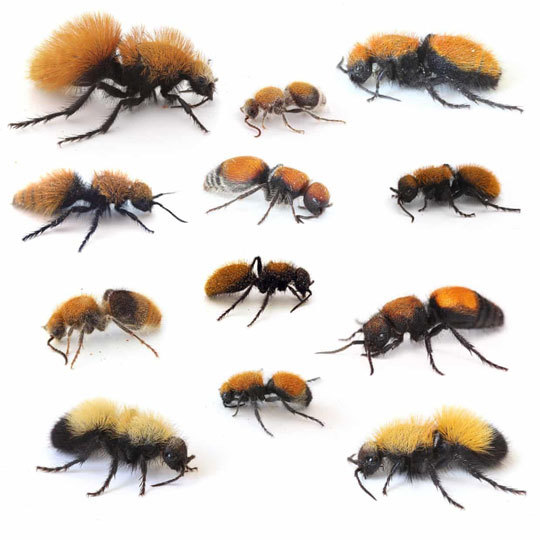
Amazing Facts about Velvet Ants
First, let's make sure we know exactly what these things are. As I said above, velvet ants are actually wasps. They exhibit what is called sexual dimorphism—meaning the males and females are very different in appearance. The males have wings and can fly, while the females are without wings and spend all their time on the ground. The wingless females can sting, but the winged males cannot.
Velvet ants are solitary wasps. They live alone instead of in colonies that have queens, workers, and drones. The adult males fly around at night, feeding on flower nectar. The wingless females also feed on nectar, but they move around on the ground, often during daylight hours.
Here is what a winged male looks like: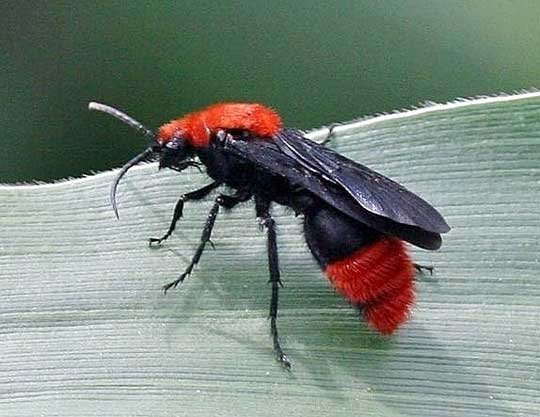
Okay, we really need to talk about this wasp's amazing ability to defend itself. It is perhaps the best-defended type of wasp. First, its stinger packs a mean punch. In fact, legend has it that the sting is powerful enough to kill a cow. Hence the name cow killer. Don't worry, this is nothing more than a legend. These wasps are not dangerous to cows or to humans (unless you are highly allergic to wasp and bee stings in general).
But the velvet ant's sting is painful! How painful? Well, first let's distinguish between pain and toxicity. Pain is how much the sting hurts, toxicity is how dangerous or fatal the sting is. Surprisingly, tests have shown that velvet ant venom (which still has an unknown composition) is no more toxic than the venom of honeybees.
It's also important to think about the velvet ant's solitary lifestyle. They live alone, so they do not have companions to help them fight off predators. It's more important for a velvet ant to administer immediate pain to a predator, so that it can make a quick escape. It's the "shock and awe" approach. When a predator grabs a velvet ant, the pain comes so fast that it will usually release the wasp before killing it.
How painful is it? In one comparative study, velvet ant pain outscored the pain from 58 other stinging insects. The only bugs rated as more painful were the bullet ant, the warrior wasp, and the tarantula hawk (a type of wasp). Even those names sound nasty, don't they?
Oh... and that was one study I am glad I did not volunteer for.
I suppose the pain is made worse by the fact that velvet ants have stingers that can be half as long as their entire body! See the stinger in the image below.
Not only do velvet ants have a nasty sting, they also make a warning sound by contracting their abdomen. This sound warns predators that the velvet ant is ready to attack (kind of like a rattlesnake's rattling). In studies, whenever a shrew would come within a meter of a velvet ant, the velvet ant would start making this sound, and the sound would become more frequent as the shrew got closer. In the study, the shrews would never attack the velvet ants.
Check out this video of a velvet ant's alarm sound and its stinger.
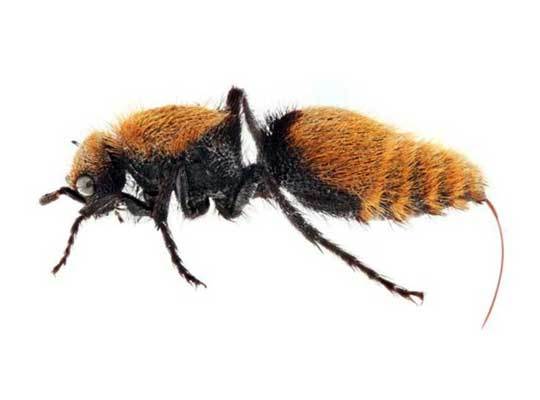
But wait! The painful sting and the threatening noise are not the velvet ant's only defenses. The bright orange and black colors are actually a form of aposematic coloration. This means they have evolved a specific combination of colors to scare off predators (kind of like the coral snake). Many predators have learned the hard way that touching a velvet ant involves pain, and they learn to avoid insects that have this color pattern.
Not only that, but velvet ants have extremely strong, hard exoskeletons. Crushing a velvet ant requires 11 times more pressure than crushing a honeybee! Yep... this has actually been measured with a device called a force transducer.
And there is one more defense. When threatened, velvet ants also squirt out an alarm chemical from their mandibular gland. It is thought that this chemical further warns the attacker that they are about get the crap stung out of them if they don't back off.
So... a painful sting, aposematic coloration, a really hard exoskeleton, a warning sound, and a warning chemical. Velvet ants are well-defended wasps!
To give you an idea of how invincible velvet ants are, in a large 2018 study, numerous species of velvet ants were placed with a variety of different predators, including amphibians, reptiles, birds, and small mammals. The wasps were attacked by moles, shrews, lizards, birds, frogs, toads, and many more predators. Only one animal, a single American toad, was able to kill and eat a velvet ant. All the others failed. Two shrews were able to wound a velvet ant, but only after several failed attempts.
The velvet ant is one tough cookie.
One last photo. Below is a species of velvet ant found in Chile. It's called the panda ant .

So, Velvet Ants deserve a place in the G.A.H.O.F.
(Gangbusters Animal Hall of Fame).
FUN FACT: The word gangbusters originated in about 1940. It comes from the popular U.S. radio crime-fighting drama called "Gang Busters," which ran from 1937-1957. The show always started with a dramatic opening involving sirens, screams, pistol shots, and jarring music. The show often involved law enforcement officials busting up organized crime gangs. Eventually, the word started being used widely to mean "outstandingly excellent or successful." Example: The new Marvel movie went gangbusters. The word can also mean "with great speed, intensity, vigor, impact, or success." Example: The software market was growing like gangbusters.
So, especially when it comes to velvet ants, gangbusters is another way to say awesome!
Photo Credits:
Immortal Jellyfish - Animal Rescue Professionals
Young chimp with stick - National Geographic
Velvet ant species comparison - Joe Wilson/Joe Wilson et al./Current Biology 2015 via The Guardian
Winged male - Johnny N. Dell, via Tallahassee Democrat
Velvet ant stinger - Joseph S. Wilson, USU, via Utah State University Today
Panda ant - Chris Lukhaup - Flickr

Here in Missouri, velvet ants are often called cow killers. This menacing name comes from their reputation for having an extremely painful sting. You see, these creatures are not actually ants at all—they are wasps.
What the heck is a Velvet Ant?
Amazingly, there are over 7,000 species of velvet ants worldwide! They are in a family called Mutillidae. As you can probably guess, they get their common name (velvet ant) from the velvety coat of fur on their bodies, which is often bright orange and black.
Here are a few of the different species:

Amazing Facts about Velvet Ants
First, let's make sure we know exactly what these things are. As I said above, velvet ants are actually wasps. They exhibit what is called sexual dimorphism—meaning the males and females are very different in appearance. The males have wings and can fly, while the females are without wings and spend all their time on the ground. The wingless females can sting, but the winged males cannot.
Velvet ants are solitary wasps. They live alone instead of in colonies that have queens, workers, and drones. The adult males fly around at night, feeding on flower nectar. The wingless females also feed on nectar, but they move around on the ground, often during daylight hours.
Here is what a winged male looks like:

Okay, we really need to talk about this wasp's amazing ability to defend itself. It is perhaps the best-defended type of wasp. First, its stinger packs a mean punch. In fact, legend has it that the sting is powerful enough to kill a cow. Hence the name cow killer. Don't worry, this is nothing more than a legend. These wasps are not dangerous to cows or to humans (unless you are highly allergic to wasp and bee stings in general).
But the velvet ant's sting is painful! How painful? Well, first let's distinguish between pain and toxicity. Pain is how much the sting hurts, toxicity is how dangerous or fatal the sting is. Surprisingly, tests have shown that velvet ant venom (which still has an unknown composition) is no more toxic than the venom of honeybees.
It's also important to think about the velvet ant's solitary lifestyle. They live alone, so they do not have companions to help them fight off predators. It's more important for a velvet ant to administer immediate pain to a predator, so that it can make a quick escape. It's the "shock and awe" approach. When a predator grabs a velvet ant, the pain comes so fast that it will usually release the wasp before killing it.
How painful is it? In one comparative study, velvet ant pain outscored the pain from 58 other stinging insects. The only bugs rated as more painful were the bullet ant, the warrior wasp, and the tarantula hawk (a type of wasp). Even those names sound nasty, don't they?
Oh... and that was one study I am glad I did not volunteer for.
I suppose the pain is made worse by the fact that velvet ants have stingers that can be half as long as their entire body! See the stinger in the image below.
Not only do velvet ants have a nasty sting, they also make a warning sound by contracting their abdomen. This sound warns predators that the velvet ant is ready to attack (kind of like a rattlesnake's rattling). In studies, whenever a shrew would come within a meter of a velvet ant, the velvet ant would start making this sound, and the sound would become more frequent as the shrew got closer. In the study, the shrews would never attack the velvet ants.
Check out this video of a velvet ant's alarm sound and its stinger.

But wait! The painful sting and the threatening noise are not the velvet ant's only defenses. The bright orange and black colors are actually a form of aposematic coloration. This means they have evolved a specific combination of colors to scare off predators (kind of like the coral snake). Many predators have learned the hard way that touching a velvet ant involves pain, and they learn to avoid insects that have this color pattern.
Not only that, but velvet ants have extremely strong, hard exoskeletons. Crushing a velvet ant requires 11 times more pressure than crushing a honeybee! Yep... this has actually been measured with a device called a force transducer.
And there is one more defense. When threatened, velvet ants also squirt out an alarm chemical from their mandibular gland. It is thought that this chemical further warns the attacker that they are about get the crap stung out of them if they don't back off.
So... a painful sting, aposematic coloration, a really hard exoskeleton, a warning sound, and a warning chemical. Velvet ants are well-defended wasps!
To give you an idea of how invincible velvet ants are, in a large 2018 study, numerous species of velvet ants were placed with a variety of different predators, including amphibians, reptiles, birds, and small mammals. The wasps were attacked by moles, shrews, lizards, birds, frogs, toads, and many more predators. Only one animal, a single American toad, was able to kill and eat a velvet ant. All the others failed. Two shrews were able to wound a velvet ant, but only after several failed attempts.
The velvet ant is one tough cookie.
One last photo. Below is a species of velvet ant found in Chile. It's called the panda ant .

So, Velvet Ants deserve a place in the G.A.H.O.F.
(Gangbusters Animal Hall of Fame).
FUN FACT: The word gangbusters originated in about 1940. It comes from the popular U.S. radio crime-fighting drama called "Gang Busters," which ran from 1937-1957. The show always started with a dramatic opening involving sirens, screams, pistol shots, and jarring music. The show often involved law enforcement officials busting up organized crime gangs. Eventually, the word started being used widely to mean "outstandingly excellent or successful." Example: The new Marvel movie went gangbusters. The word can also mean "with great speed, intensity, vigor, impact, or success." Example: The software market was growing like gangbusters.
So, especially when it comes to velvet ants, gangbusters is another way to say awesome!
Photo Credits:
Immortal Jellyfish - Animal Rescue Professionals
Young chimp with stick - National Geographic
Velvet ant species comparison - Joe Wilson/Joe Wilson et al./Current Biology 2015 via The Guardian
Winged male - Johnny N. Dell, via Tallahassee Democrat
Velvet ant stinger - Joseph S. Wilson, USU, via Utah State University Today
Panda ant - Chris Lukhaup - Flickr
Published on August 06, 2020 06:43
July 24, 2020
Awesome Animal - Social Spiders
In my new novel,
Foregone Conflict
, Skyra, Lincoln, and the team find themselves in a strange world in which Neanderthals and humans both exist. The more they learn about the people of this world, the stranger things become. The people here are oddly fascinated by spiders. Not just any spiders, though. They are fascinated specifically by
s
ocial spiders
, an amazing group of spiders that live in huge colonies (instead of individually, like most spiders do).
So, today, to celebrate the release of Foregone Conflict , I am featuring social spiders!
What the heck are Social Spiders?
It's important to remember that, as a rule, spiders are antisocial. They like to be alone. They hunt alone, they aggressively defend their webs, and many of them actually eat their own mates (which is very rude). Consider Shelob, the monstrous spider that attacks Frodo in The Lord of the Rings . Shelob hangs out alone in the caves of the Mountains of Shadows, waiting for foolish hobbits or orcs to wander too close.
But there are some species of spiders, particularly in tropical areas with an abundance of insects, that have overcome these "lone wolf" tendencies and have adopted a social existence.
Why? Because in certain circumstances, working together is better than working alone.
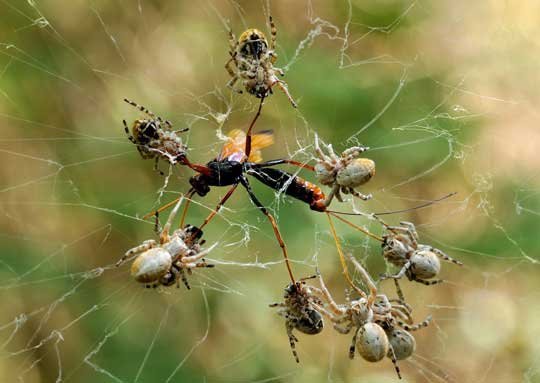
Amazing facts about Social Spiders
First, let's figure out how social spiders are different from social insects. We're all familiar with social insects like bees, wasps, and termites, which live in complex societies. These social insects often have distinct castes—each caste with distinct jobs, such as collecting food, or caring for the eggs and young, or defending the colony. There is even a queen, whose sole purpose is to lay eggs. These insects even go so far as to have different biological bodies for the members of each caste, and only a few of them ever have the opportunity to reproduce.
Social spiders, on the other hand, do not have these distinct castes, and they do not have different biological body types. Every spider in a colony looks pretty much the same as all the others. Every spider can potentially reproduce.
So, why do these spiders live in colonies instead of alone? What is the benefit of living in a group? Keep in mind that, when it comes to questions like these, it's all about mathematics. For example, one hypothesis is that living in a colony results in capturing, on average, more prey per spider. If each spider gets more food, then it is in the spiders' best interest to live in colonies. If each spider gets less food, then it is in the spiders' best interest to live alone.
As it turns out, in certain circumstances, spider colonies work better than living alone. In certain circumstances, working together to build a much larger web results in more prey per spider. Amazingly, some social spiders make webs that are 25 feet (7.6 m) tall.
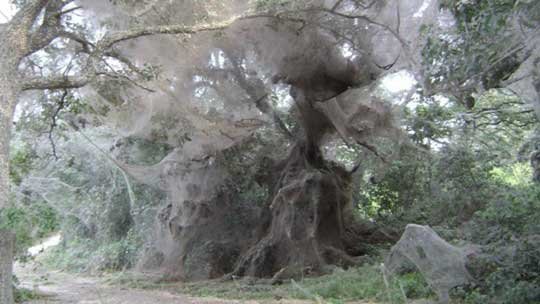
Also, in certain circumstances, it is better to have large numbers of spiders to subdue and kill larger prey. While some social spiders live in group of only a few dozen, others live in groups of up to 50,000!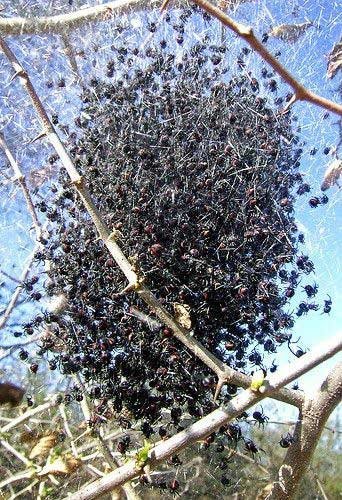
Notice that I said this is beneficial in certain circumstances. Let's figure out what these certain circumstances are. First, it is thought that living in colonies helps if the average size of the prey animals in the area is unusually large. After all, it takes a lot of spiders to subdue a bat, a bird, or a large insect. In tropical areas, there are a lot of birds and bats, and a lot of jumbo insects. This is probably why most social spiders tend to live in tropical areas.
Here's another idea—living in colonies helps if it rains a lot. Why? Because rain tends to destroy spider webs, and therefore the webs require more maintenance. More spiders equals more hands (or legs) to help out. Social spiders work together to build, maintain, and clean the massive web. Social spiders live mostly in areas that get a lot of rain.
Then, of course, there is the actual size of the web. The larger the web, the more insects and other prey it will catch. In order for a 25-foot web to catch enough prey to support thousands of spiders, it must exist in an area that has a lot of insects. You guessed it... tropical areas.
Check out this video of a social spider web.
And then there is the obvious benefit of defending against predators. Let's say you are looking for a nice spider lunch. If you find a single spider, its pretty easy to snatch it and gobble it up. But if you find an entire army of thousands of social spiders, that's an entirely different challenge. In fact, you might end up being lunch for the spiders!
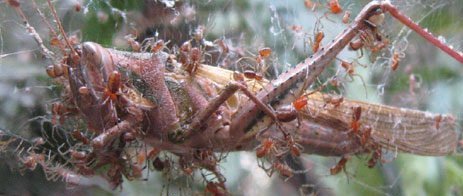
Remember, social spiders are not like social insects. Let's look at how a social spider colony works. Instead of having well-defined castes, social spiders are more egalitarian. All spiders can do all things, and they are all capable of reproducing. The roles in spider colonies are more related to age and gender. And, believe it or not, scientists are starting to discover that these spiders sort themselves by "personality." Certain spiders are more likely to spend their time attacking predators, for example. Certain spiders are more likely to repair the webs, while others are more likely to take care of the colony's babies (each colony has a spider nursery).
Astoundingly, more and more studies are showing that these roles are more likely due to individual spider personalities than to genetics. In other words, they actually choose what they want to do with their time! The social spider below, for example, which is battling an invading ant, probably has a more aggressive personality.

Even though social spiders can be very successful, this lifestyle is quite rare among spiders. There are about 45,000 spider species world-wide, but only about 25 of those are social spiders.
One last interesting tidbit. In 2013, in Santo Antonio da Platina, Brazil, a strong wind storm destroyed many of the area's social spider nests, tearing portions or entire nests free and hurling them into the air. This event led to a “spider rain” in which people in Santo Antonio da Platina observed spiders raining from the sky.
So, Social Spiders deserve a place in the P.A.H.O.F.
(Phat Animal Hall of Fame).
FUN FACT: The word phat may have originated in the early 1980s. It is thought to have started as hip-hop slang, meaning "great or excellent." It is presumably an intentional misspelling of the word fat, kind of like the word boyz. In this case, fat is being used the way it has for centuries, as slang meaning ''rich,'' as in ''fat and happy." I will point out that some people think the word phat started out with a meaning related to admiration of a woman's form (such as, pretty hips and thighs). But... this is considered incorrect, and it is assumed that this meaning may have originated as an improvised explanation to women who felt insulted by the word. Regardless, it is mostly used to mean "great or excellent," and therefore phat is another way to say awesome!
Photo Credits:
Social spiders attacking wasp - Reddit
Social spider web #1 - UnbelievableFacts
Large social spider colony - turdusprosopis on Flickr
Social spiders eating grasshopper - ThinkJungle
Social spider battling an ant - Graham Montgomery via Earth.com
So, today, to celebrate the release of Foregone Conflict , I am featuring social spiders!
What the heck are Social Spiders?
It's important to remember that, as a rule, spiders are antisocial. They like to be alone. They hunt alone, they aggressively defend their webs, and many of them actually eat their own mates (which is very rude). Consider Shelob, the monstrous spider that attacks Frodo in The Lord of the Rings . Shelob hangs out alone in the caves of the Mountains of Shadows, waiting for foolish hobbits or orcs to wander too close.
But there are some species of spiders, particularly in tropical areas with an abundance of insects, that have overcome these "lone wolf" tendencies and have adopted a social existence.
Why? Because in certain circumstances, working together is better than working alone.

Amazing facts about Social Spiders
First, let's figure out how social spiders are different from social insects. We're all familiar with social insects like bees, wasps, and termites, which live in complex societies. These social insects often have distinct castes—each caste with distinct jobs, such as collecting food, or caring for the eggs and young, or defending the colony. There is even a queen, whose sole purpose is to lay eggs. These insects even go so far as to have different biological bodies for the members of each caste, and only a few of them ever have the opportunity to reproduce.
Social spiders, on the other hand, do not have these distinct castes, and they do not have different biological body types. Every spider in a colony looks pretty much the same as all the others. Every spider can potentially reproduce.
So, why do these spiders live in colonies instead of alone? What is the benefit of living in a group? Keep in mind that, when it comes to questions like these, it's all about mathematics. For example, one hypothesis is that living in a colony results in capturing, on average, more prey per spider. If each spider gets more food, then it is in the spiders' best interest to live in colonies. If each spider gets less food, then it is in the spiders' best interest to live alone.
As it turns out, in certain circumstances, spider colonies work better than living alone. In certain circumstances, working together to build a much larger web results in more prey per spider. Amazingly, some social spiders make webs that are 25 feet (7.6 m) tall.

Also, in certain circumstances, it is better to have large numbers of spiders to subdue and kill larger prey. While some social spiders live in group of only a few dozen, others live in groups of up to 50,000!

Notice that I said this is beneficial in certain circumstances. Let's figure out what these certain circumstances are. First, it is thought that living in colonies helps if the average size of the prey animals in the area is unusually large. After all, it takes a lot of spiders to subdue a bat, a bird, or a large insect. In tropical areas, there are a lot of birds and bats, and a lot of jumbo insects. This is probably why most social spiders tend to live in tropical areas.
Here's another idea—living in colonies helps if it rains a lot. Why? Because rain tends to destroy spider webs, and therefore the webs require more maintenance. More spiders equals more hands (or legs) to help out. Social spiders work together to build, maintain, and clean the massive web. Social spiders live mostly in areas that get a lot of rain.
Then, of course, there is the actual size of the web. The larger the web, the more insects and other prey it will catch. In order for a 25-foot web to catch enough prey to support thousands of spiders, it must exist in an area that has a lot of insects. You guessed it... tropical areas.
Check out this video of a social spider web.
And then there is the obvious benefit of defending against predators. Let's say you are looking for a nice spider lunch. If you find a single spider, its pretty easy to snatch it and gobble it up. But if you find an entire army of thousands of social spiders, that's an entirely different challenge. In fact, you might end up being lunch for the spiders!

Remember, social spiders are not like social insects. Let's look at how a social spider colony works. Instead of having well-defined castes, social spiders are more egalitarian. All spiders can do all things, and they are all capable of reproducing. The roles in spider colonies are more related to age and gender. And, believe it or not, scientists are starting to discover that these spiders sort themselves by "personality." Certain spiders are more likely to spend their time attacking predators, for example. Certain spiders are more likely to repair the webs, while others are more likely to take care of the colony's babies (each colony has a spider nursery).
Astoundingly, more and more studies are showing that these roles are more likely due to individual spider personalities than to genetics. In other words, they actually choose what they want to do with their time! The social spider below, for example, which is battling an invading ant, probably has a more aggressive personality.

Even though social spiders can be very successful, this lifestyle is quite rare among spiders. There are about 45,000 spider species world-wide, but only about 25 of those are social spiders.
One last interesting tidbit. In 2013, in Santo Antonio da Platina, Brazil, a strong wind storm destroyed many of the area's social spider nests, tearing portions or entire nests free and hurling them into the air. This event led to a “spider rain” in which people in Santo Antonio da Platina observed spiders raining from the sky.
So, Social Spiders deserve a place in the P.A.H.O.F.
(Phat Animal Hall of Fame).
FUN FACT: The word phat may have originated in the early 1980s. It is thought to have started as hip-hop slang, meaning "great or excellent." It is presumably an intentional misspelling of the word fat, kind of like the word boyz. In this case, fat is being used the way it has for centuries, as slang meaning ''rich,'' as in ''fat and happy." I will point out that some people think the word phat started out with a meaning related to admiration of a woman's form (such as, pretty hips and thighs). But... this is considered incorrect, and it is assumed that this meaning may have originated as an improvised explanation to women who felt insulted by the word. Regardless, it is mostly used to mean "great or excellent," and therefore phat is another way to say awesome!
Photo Credits:
Social spiders attacking wasp - Reddit
Social spider web #1 - UnbelievableFacts
Large social spider colony - turdusprosopis on Flickr
Social spiders eating grasshopper - ThinkJungle
Social spider battling an ant - Graham Montgomery via Earth.com
Published on July 24, 2020 12:18
July 17, 2020
Awesome Animal - Megalania
My novella,
FUSED: TRAINING DAY
, features several fascinating creatures. The most bizarre of these happens to be an extinct lizard. It's not really an animal you want to have in your living room.
Way back in 1995, when Trish and I were on our first trip to Australia, we visited a natural history museum in Brisbane. There was a dark display hall with a carefully-reconstructed primeval forest. The star of the show in that forest (in my opinion) was a model of a massive monitor lizard called a megalania. That creature has stuck in my mind ever since, and I have always known I would find a way to have one show up in one of my stories.
So, since I just released FUSED: TRAINING DAY , this is also the perfect time to feature the megalania as an Awesome Animal!
What the heck is a Megalania?
During the Pleistocene (2.5 million years to about 12,000 years ago), fierce mammal predators, such a saber-toothed cats, ruled most of the world. But not so much in Australia. The apex predators in Australia were reptiles , including land-dwelling crocodiles, enormous snakes, and huge monitor lizards. The megalania was the largest of these monitor lizards.
The megalania (Megalania prisca or Varanus priscus) lived from about 1.6 million years ago to about 40,000 years ago. It is also called the giant goanna (goanna is the name given to certain monitor lizards, particularly in Australia).
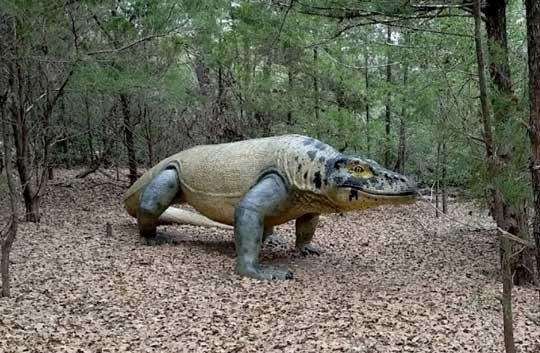
Amazing facts about the megalania
Okay, the first thing we need to do is figure out exactly how big these things were. The megalania is touted as the largest terrestrial lizard to have ever roamed the earth. Is this true?
The largest living lizard is the Komodo monitor (the Komodo dragon), which can grow to be 10 feet (3 m) long and weigh 150 pounds (70 kg). We'll use the Komodo as a standard for comparison.
The strange thing is, the assumed size of the megalania has changed greatly based upon different studies that have been done. Why? because complete fossil skeletons are rare. The earliest estimates put megalanias at about 23 feet (7 m) long and about 1370 pounds (620 kg).
In 2009, the megalania was downgraded to 18 feet (5.5 m) and 1,268 pounds (575 kg). The author of the study argued that the previous estimates used flawed methods.
However, in a completely different study published in 2004, Ralph Molnar did a very comprehensive study comparing fossil megalania bones to the bones of two different living monitor lizards. One was the lace monitor, which is long and thin, and the other was the Komodo monitor, which has a thicker body. The conclusion? If the megalania was shaped more like the lace monitor, it was 26 feet (7.9 m) long. If the megalania was shaped more like the Komodo monitor, it was 23 feet (7 m) long. The largest individuals would have weighed 4.280 pounds (1,940 kg)!
Yeah... I know what you're thinking. What difference does it make, right? Whether it's 1,200 pounds or 4,200 pounds, this was a big honkin' lizard—way, way bigger than a Komodo dragon.
In the diagram below, 3A is the small estimate, 3B is the large estimate. Lizard 1 is the Komodo dragon (the largest lizard living today).
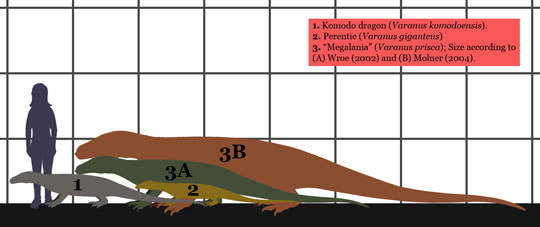
It's important to remember that we aren't talking about a dinosaur. Dinosaur skeletons were structured very differently from lizard skeletons. Dinosaurs had legs positioned directly beneath their bodies, able to support vast amounts of weight. Lizards, though, have legs that extend out to the sides. With no direct support from underneath, lizards simply cannot grow all that large. Most lizards are the size of your hand or smaller. Many are smaller than your pinky finger.
So, the megalania was a big lizard. If you saw a 4,000-pound predatory lizard coming your way, you would probably want to make yourself scarce. As if the size wasn't intimidating enough, these lizards were probably venomous . You read that right. The megalania belongs in a reptile group (specifically, a clade) called Toxicofera, which includes all the reptiles that have venom-producing glands in their mouths.
Here's how this venom works (based on what we know about living monitor lizards with venom, such as the Komodo dragon). The vemon, produced in the lizard's jaw, is a hemotoxin. This means it attacks the blood. Specifically, it prevents the blood from clotting. So... the lizard bites the heck out of its prey (Komodo dragons have a seriously nasty bite), the prey starts to bleed, and the hemotoxin greatly increases the bleeding. Soon, the prey animal goes into shock and collapses. Then... lizard lunch!
Because of the megalania's hemotoxic venom, these lizards were probably capable of taking down very large prey. The painting below shows a megalania stalking a herd of huge herbivorous marsupials.
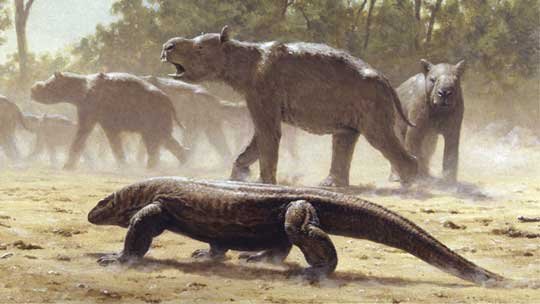
Check out this video about the megalania (kind of long but informative).
Below are two Komodo monitors fighting. They are each probably about 7 feet (2.1 m) long. Now, picture what this would look like of they were each 23 feet (7 m) long!
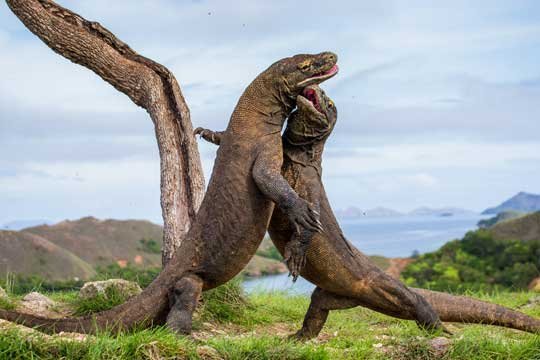
Several hypotheses have been formed to explain the extinction of megalanias, which happened about 40,000 to 50,000 years ago. First, some people suggest they went extinct after several large prey species went extinct, specifically Diprotodon and Procoptodon. When these animals disappeared, there was simply not enough food to support a population of such large lizards.
Second, some people think the first humans to colonize Australia may have hunted megalanias to extinction (try to imagine hunting an adult megalania with primitive weapons!). This hypothesis is supported by the fact that humans entered Australia at about that time.
Third, it seems likely that their extinction was caused by a combination of #1 and #2 above. Perhaps humans burned huge swaths of forest, and in doing so they killed off the food supply for megalania prey species.
And... fourth, some people like to believe that megalanias are still alive, with isolated populations hidden in remote areas of Australia. There have been stories of large footprints found, cattle killed with suspicious bite marks, and so on. BUT... as cool as it would be to find living megalanias, the possibility is HIGHLY UNLIKELY.
So, the Megalania deserve a place in the P.K.A.H.O.F.
(Peachy Keen Animal Hall of Fame).
FUN FACT: The adjective phrase peachy keen was popularized (and probably invented) by a Los Angeles DJ named Jim Hawthorne around 1948. The young DJ, it seems, was bored with his job. One night, without notifying his bosses, Hawthorne turned his show into a wild, carefree program he referred to as "Hellzapoppin on the air." Before the station could fire him, they were inundated with fan mail. The program soon exploded in popularity. One of Hawthorne's signature phrases was "Oh so peachy keen." Well, the phrase is still being used, and it means excellent, wonderful, and fine. So, peachy keen is another way to say awesome!
Photo Credits:
Megalania #1 - Dinosaur Park
Size diagram - Wikimedia Commons
Fighting Komodo monitors - DepositPhotos
Megalania stalking marsupials - Laurie Beirne via Science Magazine
Megalania pursuing a Bullockornis - Peter Trusler, via Monash University on Flickr via NatGeo
Way back in 1995, when Trish and I were on our first trip to Australia, we visited a natural history museum in Brisbane. There was a dark display hall with a carefully-reconstructed primeval forest. The star of the show in that forest (in my opinion) was a model of a massive monitor lizard called a megalania. That creature has stuck in my mind ever since, and I have always known I would find a way to have one show up in one of my stories.
So, since I just released FUSED: TRAINING DAY , this is also the perfect time to feature the megalania as an Awesome Animal!
What the heck is a Megalania?
During the Pleistocene (2.5 million years to about 12,000 years ago), fierce mammal predators, such a saber-toothed cats, ruled most of the world. But not so much in Australia. The apex predators in Australia were reptiles , including land-dwelling crocodiles, enormous snakes, and huge monitor lizards. The megalania was the largest of these monitor lizards.
The megalania (Megalania prisca or Varanus priscus) lived from about 1.6 million years ago to about 40,000 years ago. It is also called the giant goanna (goanna is the name given to certain monitor lizards, particularly in Australia).

Amazing facts about the megalania
Okay, the first thing we need to do is figure out exactly how big these things were. The megalania is touted as the largest terrestrial lizard to have ever roamed the earth. Is this true?
The largest living lizard is the Komodo monitor (the Komodo dragon), which can grow to be 10 feet (3 m) long and weigh 150 pounds (70 kg). We'll use the Komodo as a standard for comparison.
The strange thing is, the assumed size of the megalania has changed greatly based upon different studies that have been done. Why? because complete fossil skeletons are rare. The earliest estimates put megalanias at about 23 feet (7 m) long and about 1370 pounds (620 kg).
In 2009, the megalania was downgraded to 18 feet (5.5 m) and 1,268 pounds (575 kg). The author of the study argued that the previous estimates used flawed methods.
However, in a completely different study published in 2004, Ralph Molnar did a very comprehensive study comparing fossil megalania bones to the bones of two different living monitor lizards. One was the lace monitor, which is long and thin, and the other was the Komodo monitor, which has a thicker body. The conclusion? If the megalania was shaped more like the lace monitor, it was 26 feet (7.9 m) long. If the megalania was shaped more like the Komodo monitor, it was 23 feet (7 m) long. The largest individuals would have weighed 4.280 pounds (1,940 kg)!
Yeah... I know what you're thinking. What difference does it make, right? Whether it's 1,200 pounds or 4,200 pounds, this was a big honkin' lizard—way, way bigger than a Komodo dragon.
In the diagram below, 3A is the small estimate, 3B is the large estimate. Lizard 1 is the Komodo dragon (the largest lizard living today).

It's important to remember that we aren't talking about a dinosaur. Dinosaur skeletons were structured very differently from lizard skeletons. Dinosaurs had legs positioned directly beneath their bodies, able to support vast amounts of weight. Lizards, though, have legs that extend out to the sides. With no direct support from underneath, lizards simply cannot grow all that large. Most lizards are the size of your hand or smaller. Many are smaller than your pinky finger.
So, the megalania was a big lizard. If you saw a 4,000-pound predatory lizard coming your way, you would probably want to make yourself scarce. As if the size wasn't intimidating enough, these lizards were probably venomous . You read that right. The megalania belongs in a reptile group (specifically, a clade) called Toxicofera, which includes all the reptiles that have venom-producing glands in their mouths.
Here's how this venom works (based on what we know about living monitor lizards with venom, such as the Komodo dragon). The vemon, produced in the lizard's jaw, is a hemotoxin. This means it attacks the blood. Specifically, it prevents the blood from clotting. So... the lizard bites the heck out of its prey (Komodo dragons have a seriously nasty bite), the prey starts to bleed, and the hemotoxin greatly increases the bleeding. Soon, the prey animal goes into shock and collapses. Then... lizard lunch!
Because of the megalania's hemotoxic venom, these lizards were probably capable of taking down very large prey. The painting below shows a megalania stalking a herd of huge herbivorous marsupials.

Check out this video about the megalania (kind of long but informative).
Below are two Komodo monitors fighting. They are each probably about 7 feet (2.1 m) long. Now, picture what this would look like of they were each 23 feet (7 m) long!

Several hypotheses have been formed to explain the extinction of megalanias, which happened about 40,000 to 50,000 years ago. First, some people suggest they went extinct after several large prey species went extinct, specifically Diprotodon and Procoptodon. When these animals disappeared, there was simply not enough food to support a population of such large lizards.
Second, some people think the first humans to colonize Australia may have hunted megalanias to extinction (try to imagine hunting an adult megalania with primitive weapons!). This hypothesis is supported by the fact that humans entered Australia at about that time.
Third, it seems likely that their extinction was caused by a combination of #1 and #2 above. Perhaps humans burned huge swaths of forest, and in doing so they killed off the food supply for megalania prey species.
And... fourth, some people like to believe that megalanias are still alive, with isolated populations hidden in remote areas of Australia. There have been stories of large footprints found, cattle killed with suspicious bite marks, and so on. BUT... as cool as it would be to find living megalanias, the possibility is HIGHLY UNLIKELY.

So, the Megalania deserve a place in the P.K.A.H.O.F.
(Peachy Keen Animal Hall of Fame).
FUN FACT: The adjective phrase peachy keen was popularized (and probably invented) by a Los Angeles DJ named Jim Hawthorne around 1948. The young DJ, it seems, was bored with his job. One night, without notifying his bosses, Hawthorne turned his show into a wild, carefree program he referred to as "Hellzapoppin on the air." Before the station could fire him, they were inundated with fan mail. The program soon exploded in popularity. One of Hawthorne's signature phrases was "Oh so peachy keen." Well, the phrase is still being used, and it means excellent, wonderful, and fine. So, peachy keen is another way to say awesome!
Photo Credits:
Megalania #1 - Dinosaur Park
Size diagram - Wikimedia Commons
Fighting Komodo monitors - DepositPhotos
Megalania stalking marsupials - Laurie Beirne via Science Magazine
Megalania pursuing a Bullockornis - Peter Trusler, via Monash University on Flickr via NatGeo
Published on July 17, 2020 09:54
June 26, 2020
Awesome Animal - Quokka
Perhaps you have recently seen photos of a ridiculously cute-looking animal on social media—an animal that always seems to be smiling. If so, it is probably a Quokka. This creature, which is a small species of wallaby-like marsupial, has gone from being relatively unknown to becoming a selfie superstar. I recently saw a few photos, and I simply had to feature it as an Awesome Animal.
What the heck is a Quokka?
The quokka (pronounced kwok -uh) is a macropod (the family that includes kangaroos, wallabies, wallaroos, tree kangaroos, and more). They are about the size of a domestic cat, and they live in far western Australia, including several islands, especially Rottnest Island. For whatever reason, quokkas seem to have almost no fear of humans. Because of their goofy "smiles," National Geographic has deemed quokkas to be the "world's happiest animal."
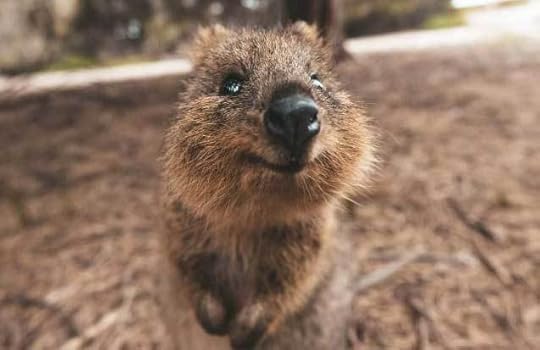
Amazing facts about Quokkas
The first person to describe quokkas was a Dutchman named Volkersen. He found many of them on an island off the west coast of Australia. In 1696 he described the creature as "a kind of rat as big as a common cat." Well, obviously they are not rats, but that did not stop Volkersen from naming the island Rotte Nest (which means rat's nest). Eventually, the island was permanently named Rottnest. The name quokka was given to the animal by the Aboriginal people of that area.
Okay, we need to talk about this creature's face, which makes the quokka a contender for the cutest animal ever. As I'm sure you're aware, quokkas are not really smiling. This is simply the shape of the creature's mouth. And those prominent front teeth often contribute to the illusion of a smile.
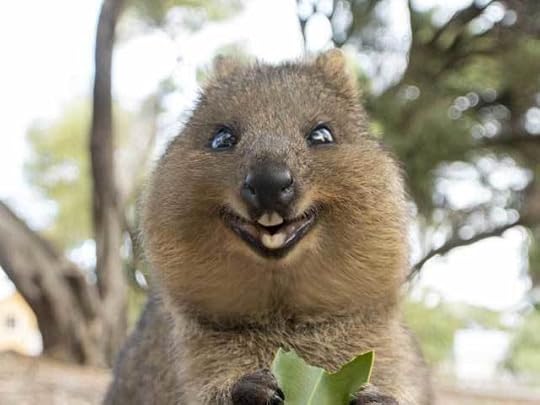
In 2015, someone visited Rottnest Island, took a selfie alongside a quokka, and posted it to social media. The image went viral, and before long, Quokka Selfies became a big deal. A REALLY big deal. If you do a Google Image search for "quokka selfies," you will find literally thousands of them. People travel to Rottnest Island just to take quokka selfies. Apparently, these photos are not difficult to take because the creatures don't mind having a big human sprawl in the grass beside them with a camera. It is illegal to touch quokkas, but that doesn't stop people from cozying up to them for photos.

Check out this video about the popularity of quokka selfies.
Quokkas are vegetarians. They primarily eat grasses, sedges, and leaves, but their favorite food is a small shrub native to Western Australia called Guichenotia ledifolia, a type of mallow. Humans are warned to not feed quokkas, and especially not human food, which can cause malnourishment and dehydration in quokkas. Rottnest Island in particular, and Australia in general, take this stuff seriously (as they should). On Rottnest Island, you will be fined $300 if you're caught feeding a quokka. You definitely don't want to get caught being cruel to them (or other animals in Australia). The maximum penalty for animal cruelty is a $50,000 fine and five years in prison.
Here's another good reason not to touch quokkas... the quokkas on Rottnest Island bite dozens of people per year. Maybe they are getting tired of selfies.
I feel the need to dispel a popular myth, that mother quokkas throw their babies at predators to escape being eaten . This idea started as a joke on social media, and since then it has become widely reported as fact. It is NOT true. However, there are some interesting facts that may have contributed to this. Quokkas are marsupials, so the mothers keep their babies in a pouch. When running away from a predator, sometimes these babies (unfortunately) fall out of the pouch. The mother keeps running, leaving the baby behind. This can also happen with other marsupials.
Here's the strange part. Studies have shown that, in quokkas, the mothers may drop the babies on purpose. When their lives are in danger from a pursuing predator, they can release their pouch muscles, causing the baby to fall out. The baby then distracts the predator, allowing the mother to escape. It's kind of like when a lizard loses its tail. The tail wriggles around, distracting the predator, allowing the lizard to escape.
Yeah, I suppose you're thinking quokkas will never get the mother-of-the-year award, but consider this. If the predator catches the mother, it will kill both the mother and the baby. If the mother escapes, she is already proven to be reproductively fertile and will likely have more babies. Yeah, the mathematics of this makes sense, but I'm sure many people still find it strange.
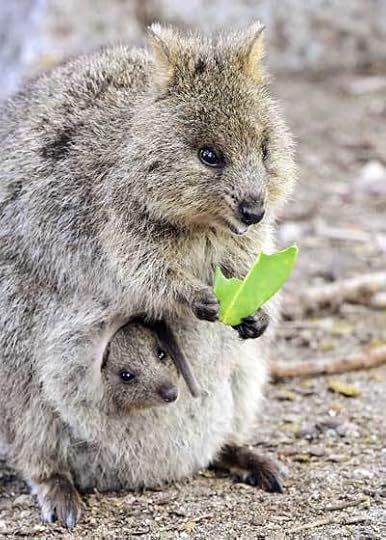
Let's talk about these babies a bit more (I don't want you to be mad at quokkas for dropping their babies). Quokkas give birth to one baby only 27 days after mating. Remember, these creatures are marsupials, so the babies are born very small, the size of a jelly bean. The tiny joey climbs from the birth canal to the pouch using its "hands." Then it stays in the pouch for about six months.
Now, this is really cool... the mother will have several other babies in her womb in a suspended state of development, ready to develop if something bad happens to the baby that was already born. These embryos are back-ups, just in case.
By the way. The fact that the mothers eject their babies when frightened is a really good reason why people should not harass these creatures!

Here's an odd tidbit of information. The relatively large population of quokkas on Rottnest Island have criminals to thank for their abundance. Why? In the late 1830s the island was designated as an Aboriginal penal colony. This kept most people away from the island, which meant that the habitat there remained undisturbed for a long time.
So, Quokkas deserve a place in the B.C.A.H.O.F.
(Blue-Chip Animal Hall of Fame).
FUN FACT:
The phrase blue-chip was first recorded in 1923. The term was used by a guy named Oliver Gingold, an employee at Dow Jones. He was describing certain stocks trading at $200 or more per share. He got this from poker, in which the blue chips were worth more than the red and white chips. Eventually, blue chip no longer meant stocks with a high price tag, but instead it referred to stocks of high-quality companies. And, as often happens, people started using the term in a broader sense, to describe people that had excellent qualities, such as a blue-chip athlete, or a blue-chip scientist.
So, blue-chip is another way to say awesome!
Photo Credits:
Quokka #1 - Tourism Australia
Quokka showing teeth - Suzana Paravac/@CruzySuzy/Instagram
Quokka selfie - Twitter
Quokka with baby - EverywhereWild
Quokka eating leaf - All That's Interesting
What the heck is a Quokka?
The quokka (pronounced kwok -uh) is a macropod (the family that includes kangaroos, wallabies, wallaroos, tree kangaroos, and more). They are about the size of a domestic cat, and they live in far western Australia, including several islands, especially Rottnest Island. For whatever reason, quokkas seem to have almost no fear of humans. Because of their goofy "smiles," National Geographic has deemed quokkas to be the "world's happiest animal."

Amazing facts about Quokkas
The first person to describe quokkas was a Dutchman named Volkersen. He found many of them on an island off the west coast of Australia. In 1696 he described the creature as "a kind of rat as big as a common cat." Well, obviously they are not rats, but that did not stop Volkersen from naming the island Rotte Nest (which means rat's nest). Eventually, the island was permanently named Rottnest. The name quokka was given to the animal by the Aboriginal people of that area.
Okay, we need to talk about this creature's face, which makes the quokka a contender for the cutest animal ever. As I'm sure you're aware, quokkas are not really smiling. This is simply the shape of the creature's mouth. And those prominent front teeth often contribute to the illusion of a smile.

In 2015, someone visited Rottnest Island, took a selfie alongside a quokka, and posted it to social media. The image went viral, and before long, Quokka Selfies became a big deal. A REALLY big deal. If you do a Google Image search for "quokka selfies," you will find literally thousands of them. People travel to Rottnest Island just to take quokka selfies. Apparently, these photos are not difficult to take because the creatures don't mind having a big human sprawl in the grass beside them with a camera. It is illegal to touch quokkas, but that doesn't stop people from cozying up to them for photos.

Check out this video about the popularity of quokka selfies.
Quokkas are vegetarians. They primarily eat grasses, sedges, and leaves, but their favorite food is a small shrub native to Western Australia called Guichenotia ledifolia, a type of mallow. Humans are warned to not feed quokkas, and especially not human food, which can cause malnourishment and dehydration in quokkas. Rottnest Island in particular, and Australia in general, take this stuff seriously (as they should). On Rottnest Island, you will be fined $300 if you're caught feeding a quokka. You definitely don't want to get caught being cruel to them (or other animals in Australia). The maximum penalty for animal cruelty is a $50,000 fine and five years in prison.
Here's another good reason not to touch quokkas... the quokkas on Rottnest Island bite dozens of people per year. Maybe they are getting tired of selfies.
I feel the need to dispel a popular myth, that mother quokkas throw their babies at predators to escape being eaten . This idea started as a joke on social media, and since then it has become widely reported as fact. It is NOT true. However, there are some interesting facts that may have contributed to this. Quokkas are marsupials, so the mothers keep their babies in a pouch. When running away from a predator, sometimes these babies (unfortunately) fall out of the pouch. The mother keeps running, leaving the baby behind. This can also happen with other marsupials.
Here's the strange part. Studies have shown that, in quokkas, the mothers may drop the babies on purpose. When their lives are in danger from a pursuing predator, they can release their pouch muscles, causing the baby to fall out. The baby then distracts the predator, allowing the mother to escape. It's kind of like when a lizard loses its tail. The tail wriggles around, distracting the predator, allowing the lizard to escape.
Yeah, I suppose you're thinking quokkas will never get the mother-of-the-year award, but consider this. If the predator catches the mother, it will kill both the mother and the baby. If the mother escapes, she is already proven to be reproductively fertile and will likely have more babies. Yeah, the mathematics of this makes sense, but I'm sure many people still find it strange.

Let's talk about these babies a bit more (I don't want you to be mad at quokkas for dropping their babies). Quokkas give birth to one baby only 27 days after mating. Remember, these creatures are marsupials, so the babies are born very small, the size of a jelly bean. The tiny joey climbs from the birth canal to the pouch using its "hands." Then it stays in the pouch for about six months.
Now, this is really cool... the mother will have several other babies in her womb in a suspended state of development, ready to develop if something bad happens to the baby that was already born. These embryos are back-ups, just in case.
By the way. The fact that the mothers eject their babies when frightened is a really good reason why people should not harass these creatures!

Here's an odd tidbit of information. The relatively large population of quokkas on Rottnest Island have criminals to thank for their abundance. Why? In the late 1830s the island was designated as an Aboriginal penal colony. This kept most people away from the island, which meant that the habitat there remained undisturbed for a long time.
So, Quokkas deserve a place in the B.C.A.H.O.F.
(Blue-Chip Animal Hall of Fame).
FUN FACT:
The phrase blue-chip was first recorded in 1923. The term was used by a guy named Oliver Gingold, an employee at Dow Jones. He was describing certain stocks trading at $200 or more per share. He got this from poker, in which the blue chips were worth more than the red and white chips. Eventually, blue chip no longer meant stocks with a high price tag, but instead it referred to stocks of high-quality companies. And, as often happens, people started using the term in a broader sense, to describe people that had excellent qualities, such as a blue-chip athlete, or a blue-chip scientist.
So, blue-chip is another way to say awesome!
Photo Credits:
Quokka #1 - Tourism Australia
Quokka showing teeth - Suzana Paravac/@CruzySuzy/Instagram
Quokka selfie - Twitter
Quokka with baby - EverywhereWild
Quokka eating leaf - All That's Interesting
Published on June 26, 2020 05:40
June 19, 2020
Awesome Animal - Orangutan
Some animals, like the orangutan, are so obviously awesome that I never think to do a feature about them. Well, I happened to see a photo of an orangutan the other day, and I decided it's time for this creature to have its day in the spotlight.
What the heck is an Orangutan?
There are actually three species of orangutans, the Bornean orangutan, the Sumatran orangutan, and the Tapanuli orangutan. They are members of the Great Apes family, called Hominidae. This family, the Hominids, also includes gorillas, chimpanzees, bonobos, and humans. Orangutans currently live only in the rainforests of Sumatra and Bornea in Southeast Asia.

Amazing facts about Orangutans
First let's figure out exactly where Sumatra and Borneo are. These are two very large islands in Indonesia. Sumatra is the sixth largest island in the world, and Borneo is the third largest island (in case you're wondering, the largest island in the world is Greenland, the second largest is New Guinea). Here's where Sumatra and Borneo are:

Orangutans are sexually dimorphic, which means the males and females are very different in ways beyond just their sexual organs. Male orangutans are much larger than females. The males average 165 pounds (75 kg), while the females average only 82 pounds (37 kg).
The orangutan is one of the closest relatives to humans—these creatures share about 97% of the same DNA with us. In fact, the word orangutan came from the Malay words orang hutan, which means "human of the forest."
Orangutans have longer arms than humans, but shorter legs. A typical male orangutan has an arm span of about 6.6 feet (2 m), which is longer than an orangutan's standing height (about 5 feet). Check out the arms on this male:
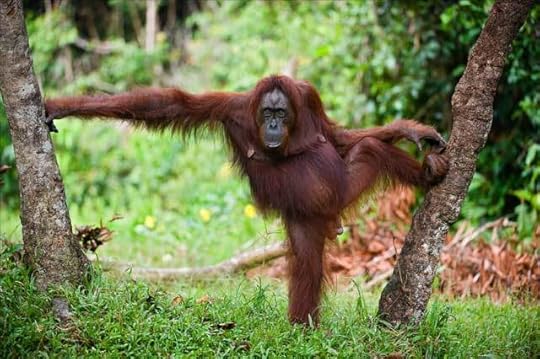
As you can probably guess from the length of those crazy arms, orangutans spend much of their time climbing in trees. In fact, they spend over 95% of their time in trees. They even make nests of branches and leaves and sleep high in the trees. They eat, sleep, and travel in the rainforest canopy.
They travel in the trees? Wouldn't it be easier to just come down to the ground and travel? It would be for you and me, but orangutans are highly skilled at moving through the branches using both their feet and their hands, a process called quadrumanous scrambling. I love that phrase... quadrumanous scrambling.
To help them with this quadrumanous scrambling, orangutans have some cool adaptations. First, the muscles and tendons in their hands are arranged so that their hands are in the hooked position when at rest. This allows them to hold on to a branch without expending much effort in keeping their grip. Second, they have long fingers, but the thumb is really short. This gets the thumb out of the way so that their fingers can wrap all the way around a smaller branch and tuck between the branch and the palm, thus locking the grip. Third, their feet have long toes and an opposable thumb, so that they can also grip branches with their feet.
Check out this video of climbing orangutans.
Notice the size and position of the orangutan's thumb:
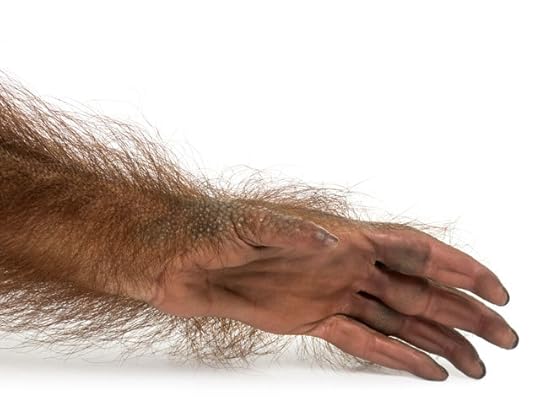
Orangutans also have extremely flexible shoulder and hip joints, allowing them to hang in almost any position. They can even do cool things like put their feet behind their heads.
Orangutans are strong. Most of their strength is in their arms. Here's why. Think about it—human strength is mostly in our lower torso and legs. That's because we are adapted for walking and running long distances. Well, orangutans are adapted for quadrumanous scrambling! They need to travel long distances using their arms (and legs, although in a way that is different from walking).
How strong are they? Well, an average, untrained human can leg press about 200% of his/her body weight, which makes our legs about 120% stronger than our arms. But an orangutan's arms are about 300% stronger than its legs. An average orangutan's arms are about 6 times stronger than an average human's arms. I do not recommend challenging an orangutan to an arm wrestling match.
I'm not fond of using animals for such spectacles, and the premise of this is ridiculous, but here is a video of a tug-of-war between an orangutan and a sumo wrestler.
Orangutans used to live throughout most of Asia, including as far north as China. Deforestation and the spread of humans have caused their range to shrink to only Sumatra and Borneo. Unfortunately, even these islands are rapidly losing their rainforest habitat suitable for orangutans. In Sumatra, there were about 12,000 orangutans in 1993, but now there are only 3,500. In Borneo, there are less than 35,000. That's all that remains of an amazing group of apes. When they're gone, they'll be gone forever.
Among the extinct species of orangutan is one with the name of Gigantopithecus blacki. This was the largest ape that ever lived (that we know of). Based on finds that only include jaws and teeth, scientists have concluded that these orangutans weighed as much as 660 pounds (300 kg).
Female orangutans are terrific (and patient) parents. They give birth only about once every eight years (they live over thirty years). Why only once per eight years? Because they are usually busy raising the previous offspring. The young orangutan will stay with its mother constantly as she cares for it and teaches it all the necessary skills to survive. This usually takes six to seven years! One of the main skills the mother teaches is how to build a proper sleeping nest, which orangutans do almost every evening. It usually takes three years for the young orangutans to master this skill!
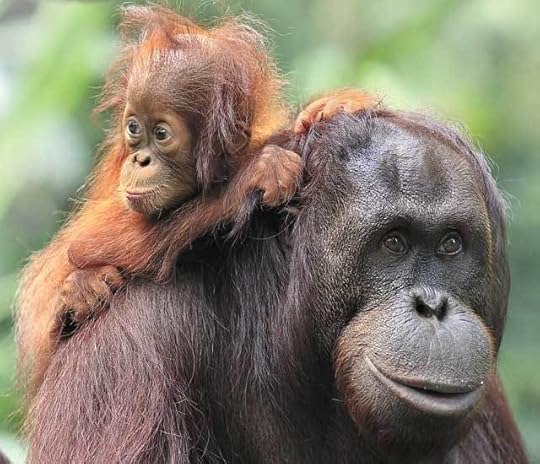
As you probably know, orangutans are intelligent, among the most intelligent of nonhuman creatures. Orangutans can learn sign language, and there is even evidence that they quickly learn to make new sounds for vocal communication. They have voluntary control over vocal fold oscillation, an ability that is essential for humans to be able to speak. Orangutans use tools such as sticks to extract insects from tree crevices, and sticks for extracting seeds from fruits. The tools they use vary from one population to another, which means that tool use is cultural. They even use tools in vocal communication. For example, they roll up large leaves and use them like a megaphone to amplify the kiss-squeak sounds they like to make. It is thought that they enjoy doing this because it tricks the listener into thinking they are larger than they really are.
I'll wrap this up with a photo of an orangutan with extraordinarily long hair.

So, Orangutans deserve a place in the N.A.H.O.F.
(Nifty Animal Hall of Fame).
FUN FACT: The word nifty originated in the 1800s. It may have started as theatrical slang. It was first seen in print in 1868, in a poem by Bret Harte, who said the word was derived from the word Magnificat (the actual title of the Song of Mary, a traditional song of praise). Nifty is an adjective meaning "very attractive or appealing" (as in, "a nifty new hat for Easter"). Or it can mean "very interesting or clever" (as in, "a nifty idea"). It can also mean "substantial, sizable" (as in, "I sold the car for a nifty profit").
So, nifty is another way to say awesome!
Photo Credits:
Orangutan with young #1 - Wanderlust
Orangutan arms and legs (photo #2) - Depositphotos Stock Photos
Orangutan hand - Depositphotos Stock Photos
Orangutan mother with young - Depositphotos Stock Photos
Orangutan with long hair - By David Arvidsson - via Wikimedia Commons
What the heck is an Orangutan?
There are actually three species of orangutans, the Bornean orangutan, the Sumatran orangutan, and the Tapanuli orangutan. They are members of the Great Apes family, called Hominidae. This family, the Hominids, also includes gorillas, chimpanzees, bonobos, and humans. Orangutans currently live only in the rainforests of Sumatra and Bornea in Southeast Asia.

Amazing facts about Orangutans
First let's figure out exactly where Sumatra and Borneo are. These are two very large islands in Indonesia. Sumatra is the sixth largest island in the world, and Borneo is the third largest island (in case you're wondering, the largest island in the world is Greenland, the second largest is New Guinea). Here's where Sumatra and Borneo are:

Orangutans are sexually dimorphic, which means the males and females are very different in ways beyond just their sexual organs. Male orangutans are much larger than females. The males average 165 pounds (75 kg), while the females average only 82 pounds (37 kg).
The orangutan is one of the closest relatives to humans—these creatures share about 97% of the same DNA with us. In fact, the word orangutan came from the Malay words orang hutan, which means "human of the forest."
Orangutans have longer arms than humans, but shorter legs. A typical male orangutan has an arm span of about 6.6 feet (2 m), which is longer than an orangutan's standing height (about 5 feet). Check out the arms on this male:

As you can probably guess from the length of those crazy arms, orangutans spend much of their time climbing in trees. In fact, they spend over 95% of their time in trees. They even make nests of branches and leaves and sleep high in the trees. They eat, sleep, and travel in the rainforest canopy.
They travel in the trees? Wouldn't it be easier to just come down to the ground and travel? It would be for you and me, but orangutans are highly skilled at moving through the branches using both their feet and their hands, a process called quadrumanous scrambling. I love that phrase... quadrumanous scrambling.
To help them with this quadrumanous scrambling, orangutans have some cool adaptations. First, the muscles and tendons in their hands are arranged so that their hands are in the hooked position when at rest. This allows them to hold on to a branch without expending much effort in keeping their grip. Second, they have long fingers, but the thumb is really short. This gets the thumb out of the way so that their fingers can wrap all the way around a smaller branch and tuck between the branch and the palm, thus locking the grip. Third, their feet have long toes and an opposable thumb, so that they can also grip branches with their feet.
Check out this video of climbing orangutans.
Notice the size and position of the orangutan's thumb:

Orangutans also have extremely flexible shoulder and hip joints, allowing them to hang in almost any position. They can even do cool things like put their feet behind their heads.
Orangutans are strong. Most of their strength is in their arms. Here's why. Think about it—human strength is mostly in our lower torso and legs. That's because we are adapted for walking and running long distances. Well, orangutans are adapted for quadrumanous scrambling! They need to travel long distances using their arms (and legs, although in a way that is different from walking).
How strong are they? Well, an average, untrained human can leg press about 200% of his/her body weight, which makes our legs about 120% stronger than our arms. But an orangutan's arms are about 300% stronger than its legs. An average orangutan's arms are about 6 times stronger than an average human's arms. I do not recommend challenging an orangutan to an arm wrestling match.
I'm not fond of using animals for such spectacles, and the premise of this is ridiculous, but here is a video of a tug-of-war between an orangutan and a sumo wrestler.
Orangutans used to live throughout most of Asia, including as far north as China. Deforestation and the spread of humans have caused their range to shrink to only Sumatra and Borneo. Unfortunately, even these islands are rapidly losing their rainforest habitat suitable for orangutans. In Sumatra, there were about 12,000 orangutans in 1993, but now there are only 3,500. In Borneo, there are less than 35,000. That's all that remains of an amazing group of apes. When they're gone, they'll be gone forever.
Among the extinct species of orangutan is one with the name of Gigantopithecus blacki. This was the largest ape that ever lived (that we know of). Based on finds that only include jaws and teeth, scientists have concluded that these orangutans weighed as much as 660 pounds (300 kg).
Female orangutans are terrific (and patient) parents. They give birth only about once every eight years (they live over thirty years). Why only once per eight years? Because they are usually busy raising the previous offspring. The young orangutan will stay with its mother constantly as she cares for it and teaches it all the necessary skills to survive. This usually takes six to seven years! One of the main skills the mother teaches is how to build a proper sleeping nest, which orangutans do almost every evening. It usually takes three years for the young orangutans to master this skill!

As you probably know, orangutans are intelligent, among the most intelligent of nonhuman creatures. Orangutans can learn sign language, and there is even evidence that they quickly learn to make new sounds for vocal communication. They have voluntary control over vocal fold oscillation, an ability that is essential for humans to be able to speak. Orangutans use tools such as sticks to extract insects from tree crevices, and sticks for extracting seeds from fruits. The tools they use vary from one population to another, which means that tool use is cultural. They even use tools in vocal communication. For example, they roll up large leaves and use them like a megaphone to amplify the kiss-squeak sounds they like to make. It is thought that they enjoy doing this because it tricks the listener into thinking they are larger than they really are.
I'll wrap this up with a photo of an orangutan with extraordinarily long hair.

So, Orangutans deserve a place in the N.A.H.O.F.
(Nifty Animal Hall of Fame).
FUN FACT: The word nifty originated in the 1800s. It may have started as theatrical slang. It was first seen in print in 1868, in a poem by Bret Harte, who said the word was derived from the word Magnificat (the actual title of the Song of Mary, a traditional song of praise). Nifty is an adjective meaning "very attractive or appealing" (as in, "a nifty new hat for Easter"). Or it can mean "very interesting or clever" (as in, "a nifty idea"). It can also mean "substantial, sizable" (as in, "I sold the car for a nifty profit").
So, nifty is another way to say awesome!
Photo Credits:
Orangutan with young #1 - Wanderlust
Orangutan arms and legs (photo #2) - Depositphotos Stock Photos
Orangutan hand - Depositphotos Stock Photos
Orangutan mother with young - Depositphotos Stock Photos
Orangutan with long hair - By David Arvidsson - via Wikimedia Commons
Published on June 19, 2020 17:33
June 5, 2020
Awesome Animal - Glasswing Butterfly
I consider some creatures to be Awesome Animals simply because they are amazingly beautiful. Glasswing butterflies are a great example. As it turns out, though, these insects have plenty of other fascinating characteristics besides their beauty.
What the heck is a Glasswing Butterfly?
Glasswing butterflies include about 370 species in a subfamily called Danainae. These butterflies live throughout Central and South America. They are called glasswing because at least part of their wings are transparent, like glass.

Amazing facts about Glasswing Butterflies
Let's talk about those crazy transparent wings, including the how and the why.
How. Here is an oversimplified statement: they are transparent because they don't reflect very much light. Instead of being reflected, light passes right through them (including infrared, visible light, and ultraviolet). As you probably know, the colors of other butterfly wings are due to the light being reflected and scattered in certain ways by the tiny structures on the wing surface. Well, the nanostructure of glasswing butterfly wings is different. Instead of having orderly rows of microscopic structures, these butterfly wings have randomly-scattered pillars, each pillar 50 to 100 times thinner than a human hair. Not only are these pillars randomly scattered, they are also of different heights and thicknesses. All of this randomness has the effect of redirecting the light through the wings instead of reflecting it.
See these random pillars below.
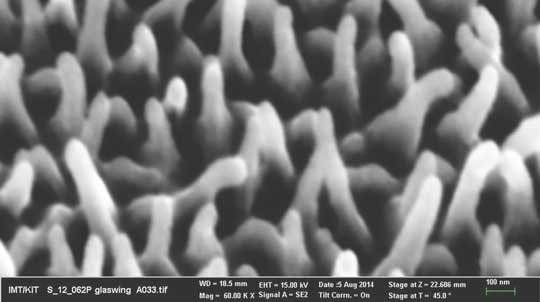
Amazingly, these wing surfaces are much less reflective than glass, and scientists are studying them to help develop less reflective coverings for screens. You know... such as the screen you are looking at right now as you read this text.
Not only that, but these surfaces are extremely water repellant. This is important to the butterflies because, if raindrops stick to their wings, the weight of the water will keep them from flying.
As if that weren't cool enough, the wing surfaces are self cleaning. So, glasswing butterflies might help us develop screens that can be viewed even in direct sunlight, and repel water, and are self cleaning!
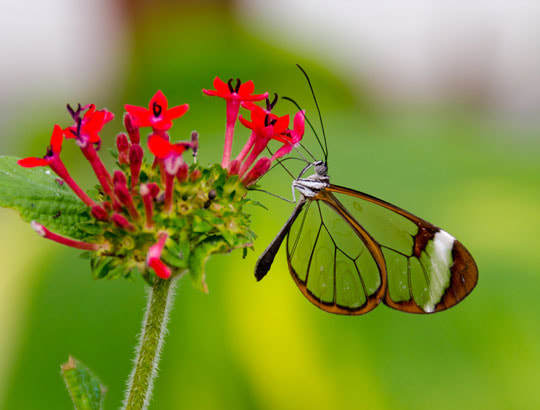
Now let's look at why they have transparent wings. The main predators of glasswing butterflies are birds. Birds typically catch butterflies in mid-flight, but these clear wings make it extremely difficult to track the butterflies' movements during flight. This kind of camouflage—transparency—is extremely rare in nature, making these butterflies pretty darn special.
But that's not the only defense these insects have against predators. Here's one that's REALLY cool. Glasswing butterflies give their mates a very special nuptial gift—poison.
You read that correctly. Poison. Here's how it works. Male glasswing butterflies have a super-duper sense of smell. Why? So that they can locate certain flowers called asters. These particular asters are special because they contain seriously-lethal poisons called pyrrolizidine alkaloids.
So, the males gobble up these poisons and store them in their body. This makes the male butterfly really nasty-tasting and toxic to predators. Then, when the male finds a suitable female, he offers these poisons as a gift. That's a romantic way of saying that the toxic nectar from the flowers is converted to pheromones that attract the females. Not only that, but the toxins are concentrated in the male's body in a spermatophore (a package containing sperm), which is transferred to the female if she finds the male attractive. This poison goes into the female's body and makes her nasty-tasting and toxic to predators. What a generous gift.
It doesn't end there! The sperm cells in the spermatophore fertilize the female's eggs, and the toxin even makes the eggs nasty-tasting and toxic to predators. And... guess where the females lay their eggs... they lay them on those same types of aster plants. So, when the larvae hatch out, they consume the plant so that they become caterpillars that are nasty-tasting and toxic to predators.
The bottom line... glasswing butterflies are pretty to look at, but don't eat them. Also, female glasswing butterflies consider an offering pf poison to be very romantic.
Check out this video about glasswing butterflies giving the nuptial gift of poison
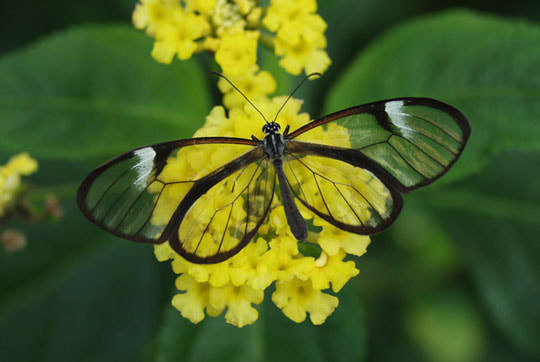
Here's another fascinating aspect of glasswing butterfly mating behavior. The males take part in a behavior called lekking. This is kind of like a buffet for females, a place for one-stop shopping for a suitable male. The males congregate together in one area, then each of them establishes his own little territory within that area—a territory he defends aggressively from the other males. With numerous males concentrated in one small area, when they all release their love pheromones, the concentrated pheromones attract females from great distances. The females converge on the lekking area and shop around, choosing a male based upon the quality of his little territory.
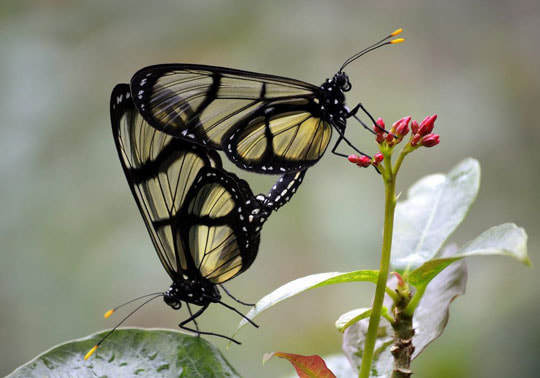
So, Glasswing Butterflies deserve a place in the D.A.H.O.F.
(Devine Animal Hall of Fame).
FUN FACT: The word devine originated sometime between 1275 and 1325. Originally it meant "godlike; characteristic of or befitting a deity." It came from the Latin divus, "of or belonging to a god, inspired, prophetic." As with many such words, it gradually developed a broader meaning, and by the late 1400s it was being used to mean "excellent in the highest degree, heavenly." In that sense, it is still in use today. So, divine is another way to say awesome!
Photo Credits:
Glasswing butterfly #1 - David Tiller, Wikimedia Commons
Microscope view of wing structure - Radwanul Hasan Siddique via Newatlas
Glasswing butterfly on red flowers - Scott Wilie, Wikimedia Commons
Glasswing butterfly on yellow flowers - Reiman Gardens
Glasswing butterflies mating - EcoQueenFaye
What the heck is a Glasswing Butterfly?
Glasswing butterflies include about 370 species in a subfamily called Danainae. These butterflies live throughout Central and South America. They are called glasswing because at least part of their wings are transparent, like glass.

Amazing facts about Glasswing Butterflies
Let's talk about those crazy transparent wings, including the how and the why.
How. Here is an oversimplified statement: they are transparent because they don't reflect very much light. Instead of being reflected, light passes right through them (including infrared, visible light, and ultraviolet). As you probably know, the colors of other butterfly wings are due to the light being reflected and scattered in certain ways by the tiny structures on the wing surface. Well, the nanostructure of glasswing butterfly wings is different. Instead of having orderly rows of microscopic structures, these butterfly wings have randomly-scattered pillars, each pillar 50 to 100 times thinner than a human hair. Not only are these pillars randomly scattered, they are also of different heights and thicknesses. All of this randomness has the effect of redirecting the light through the wings instead of reflecting it.
See these random pillars below.

Amazingly, these wing surfaces are much less reflective than glass, and scientists are studying them to help develop less reflective coverings for screens. You know... such as the screen you are looking at right now as you read this text.
Not only that, but these surfaces are extremely water repellant. This is important to the butterflies because, if raindrops stick to their wings, the weight of the water will keep them from flying.
As if that weren't cool enough, the wing surfaces are self cleaning. So, glasswing butterflies might help us develop screens that can be viewed even in direct sunlight, and repel water, and are self cleaning!

Now let's look at why they have transparent wings. The main predators of glasswing butterflies are birds. Birds typically catch butterflies in mid-flight, but these clear wings make it extremely difficult to track the butterflies' movements during flight. This kind of camouflage—transparency—is extremely rare in nature, making these butterflies pretty darn special.
But that's not the only defense these insects have against predators. Here's one that's REALLY cool. Glasswing butterflies give their mates a very special nuptial gift—poison.
You read that correctly. Poison. Here's how it works. Male glasswing butterflies have a super-duper sense of smell. Why? So that they can locate certain flowers called asters. These particular asters are special because they contain seriously-lethal poisons called pyrrolizidine alkaloids.
So, the males gobble up these poisons and store them in their body. This makes the male butterfly really nasty-tasting and toxic to predators. Then, when the male finds a suitable female, he offers these poisons as a gift. That's a romantic way of saying that the toxic nectar from the flowers is converted to pheromones that attract the females. Not only that, but the toxins are concentrated in the male's body in a spermatophore (a package containing sperm), which is transferred to the female if she finds the male attractive. This poison goes into the female's body and makes her nasty-tasting and toxic to predators. What a generous gift.
It doesn't end there! The sperm cells in the spermatophore fertilize the female's eggs, and the toxin even makes the eggs nasty-tasting and toxic to predators. And... guess where the females lay their eggs... they lay them on those same types of aster plants. So, when the larvae hatch out, they consume the plant so that they become caterpillars that are nasty-tasting and toxic to predators.
The bottom line... glasswing butterflies are pretty to look at, but don't eat them. Also, female glasswing butterflies consider an offering pf poison to be very romantic.
Check out this video about glasswing butterflies giving the nuptial gift of poison

Here's another fascinating aspect of glasswing butterfly mating behavior. The males take part in a behavior called lekking. This is kind of like a buffet for females, a place for one-stop shopping for a suitable male. The males congregate together in one area, then each of them establishes his own little territory within that area—a territory he defends aggressively from the other males. With numerous males concentrated in one small area, when they all release their love pheromones, the concentrated pheromones attract females from great distances. The females converge on the lekking area and shop around, choosing a male based upon the quality of his little territory.

So, Glasswing Butterflies deserve a place in the D.A.H.O.F.
(Devine Animal Hall of Fame).
FUN FACT: The word devine originated sometime between 1275 and 1325. Originally it meant "godlike; characteristic of or befitting a deity." It came from the Latin divus, "of or belonging to a god, inspired, prophetic." As with many such words, it gradually developed a broader meaning, and by the late 1400s it was being used to mean "excellent in the highest degree, heavenly." In that sense, it is still in use today. So, divine is another way to say awesome!
Photo Credits:
Glasswing butterfly #1 - David Tiller, Wikimedia Commons
Microscope view of wing structure - Radwanul Hasan Siddique via Newatlas
Glasswing butterfly on red flowers - Scott Wilie, Wikimedia Commons
Glasswing butterfly on yellow flowers - Reiman Gardens
Glasswing butterflies mating - EcoQueenFaye
Published on June 05, 2020 17:02



